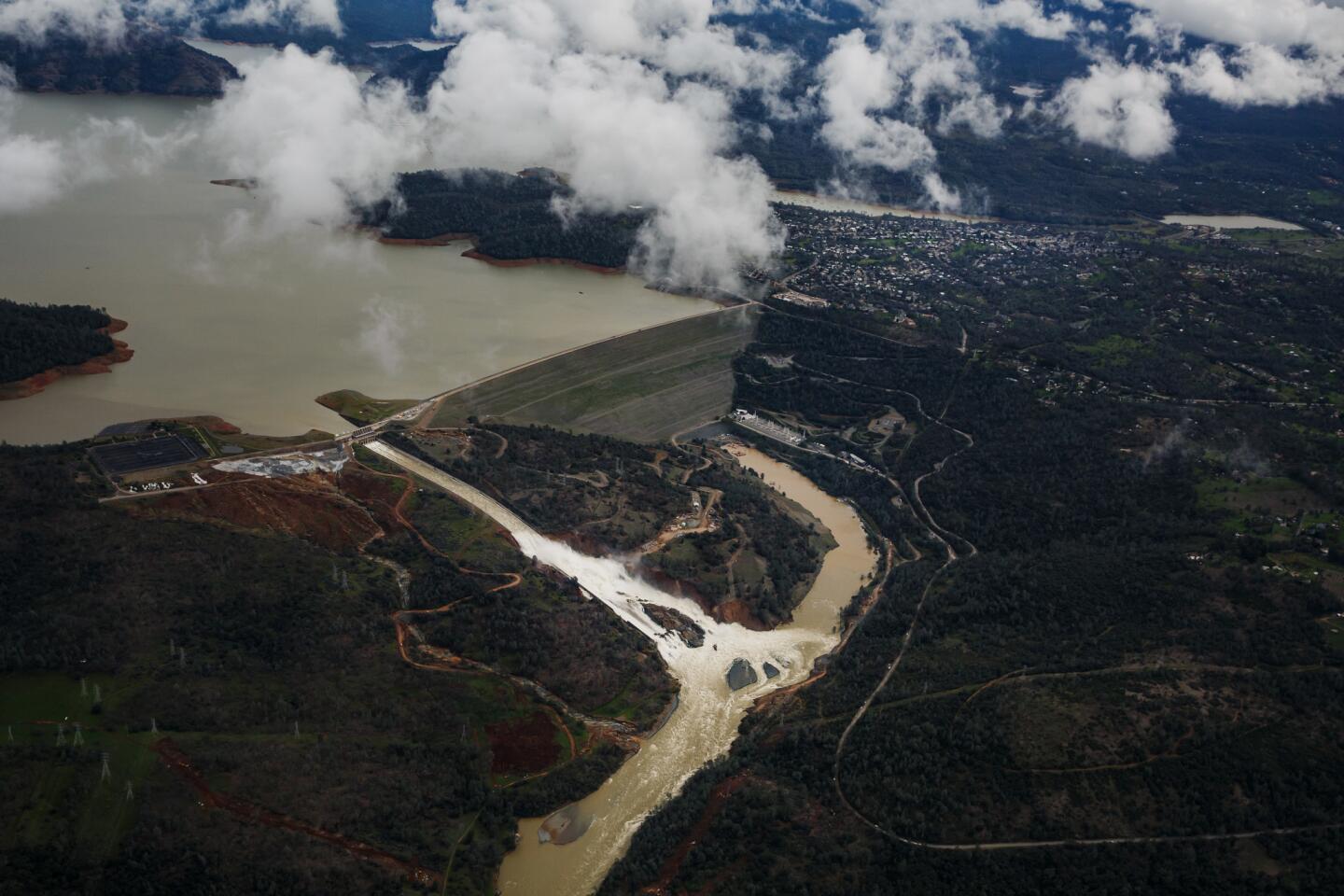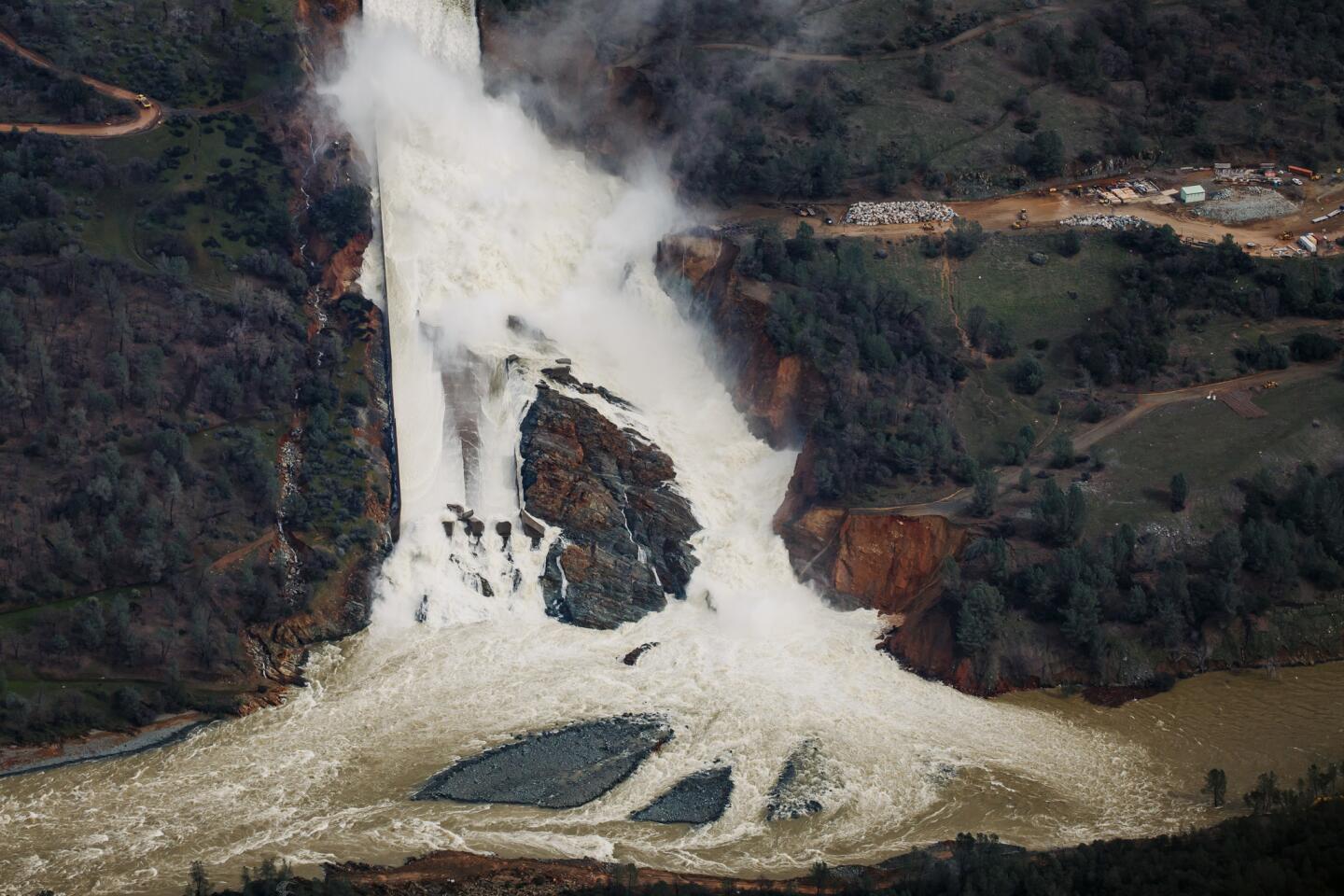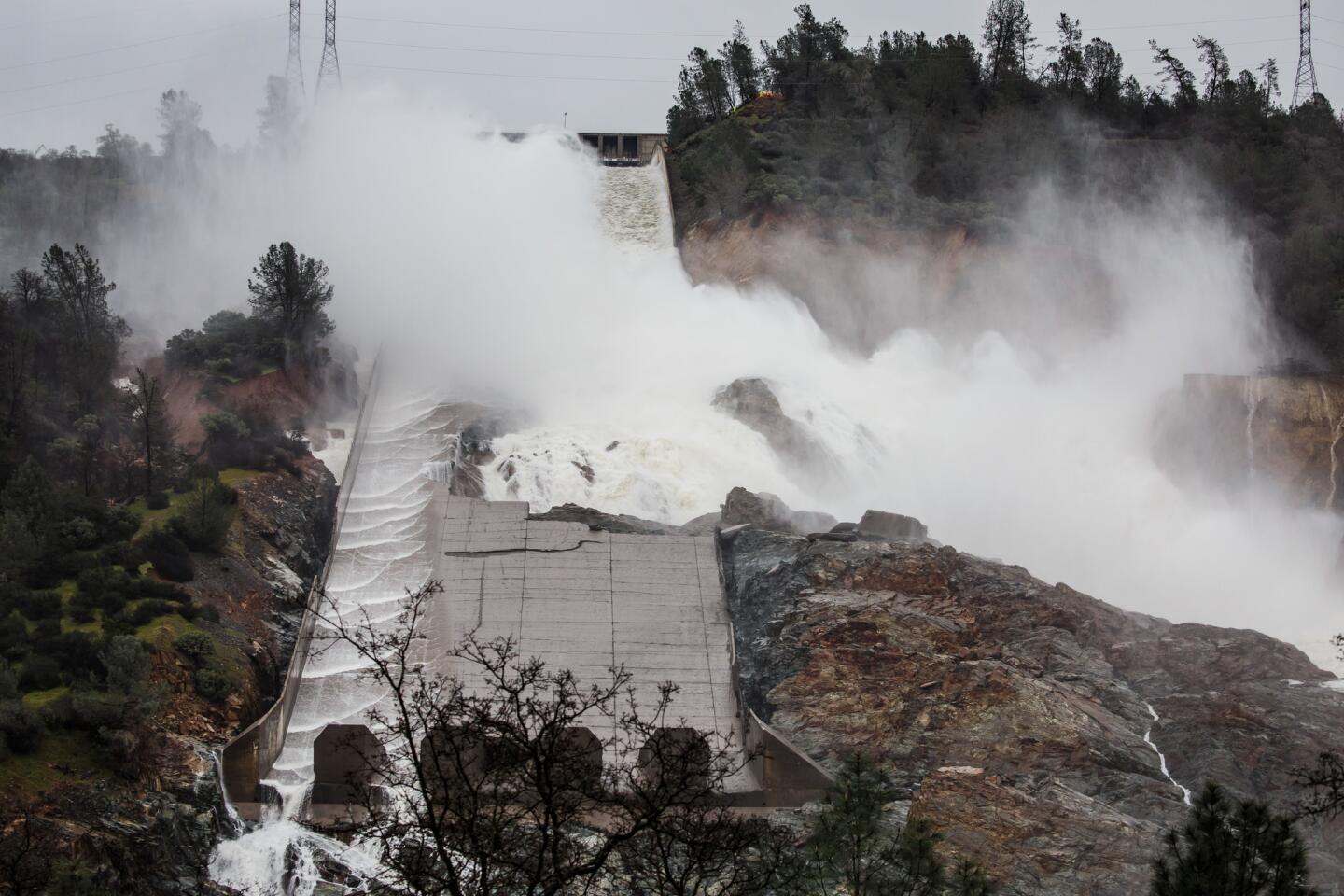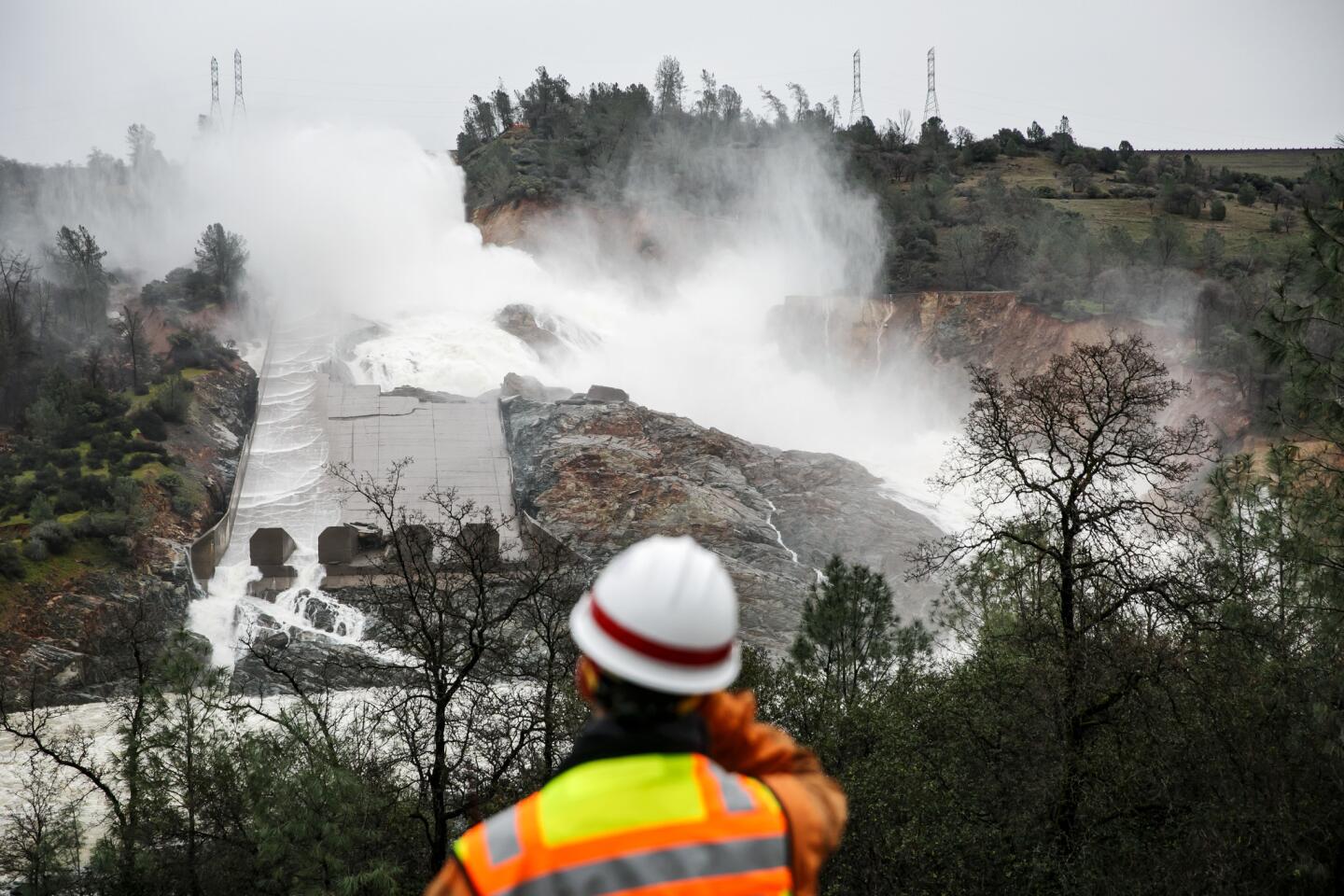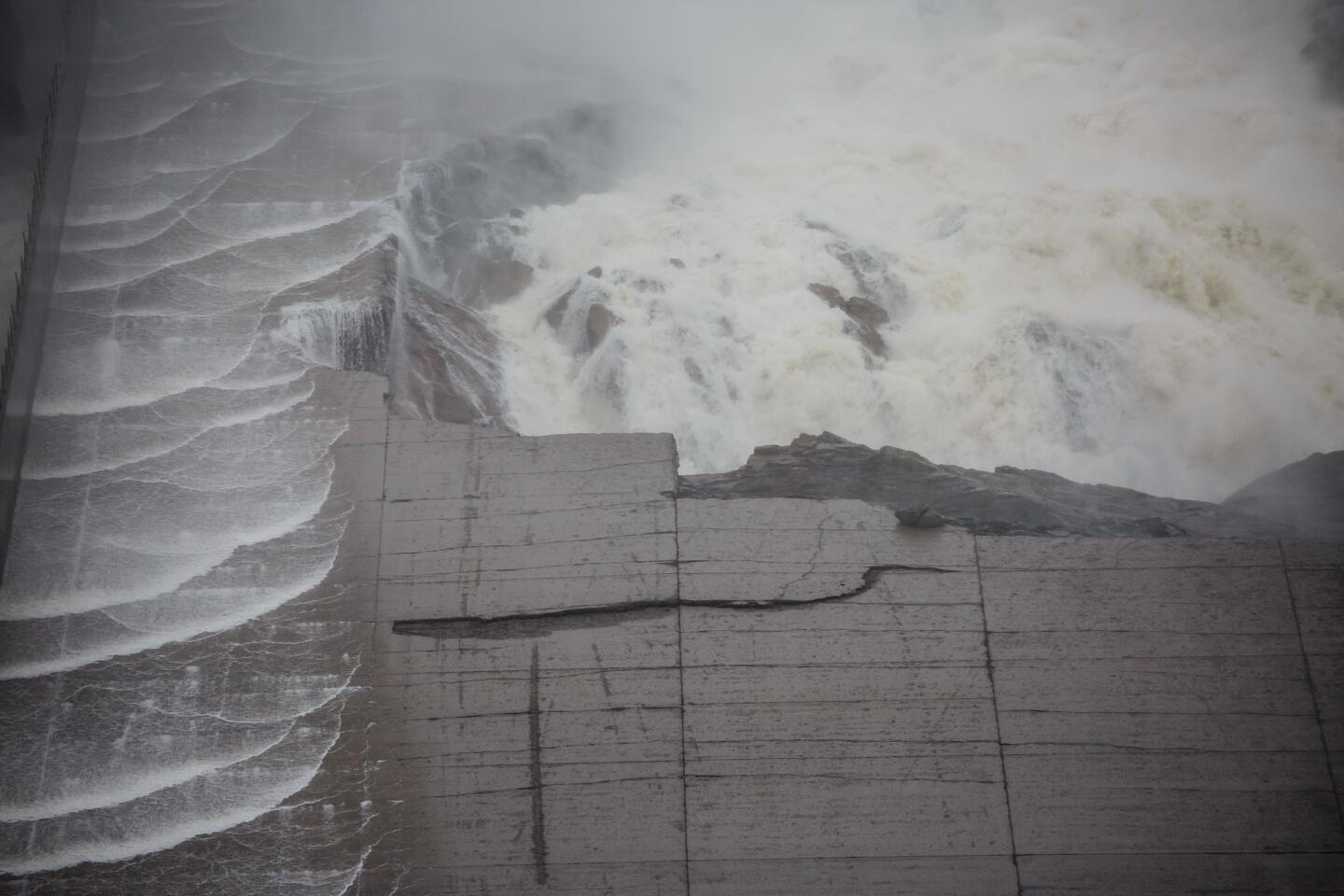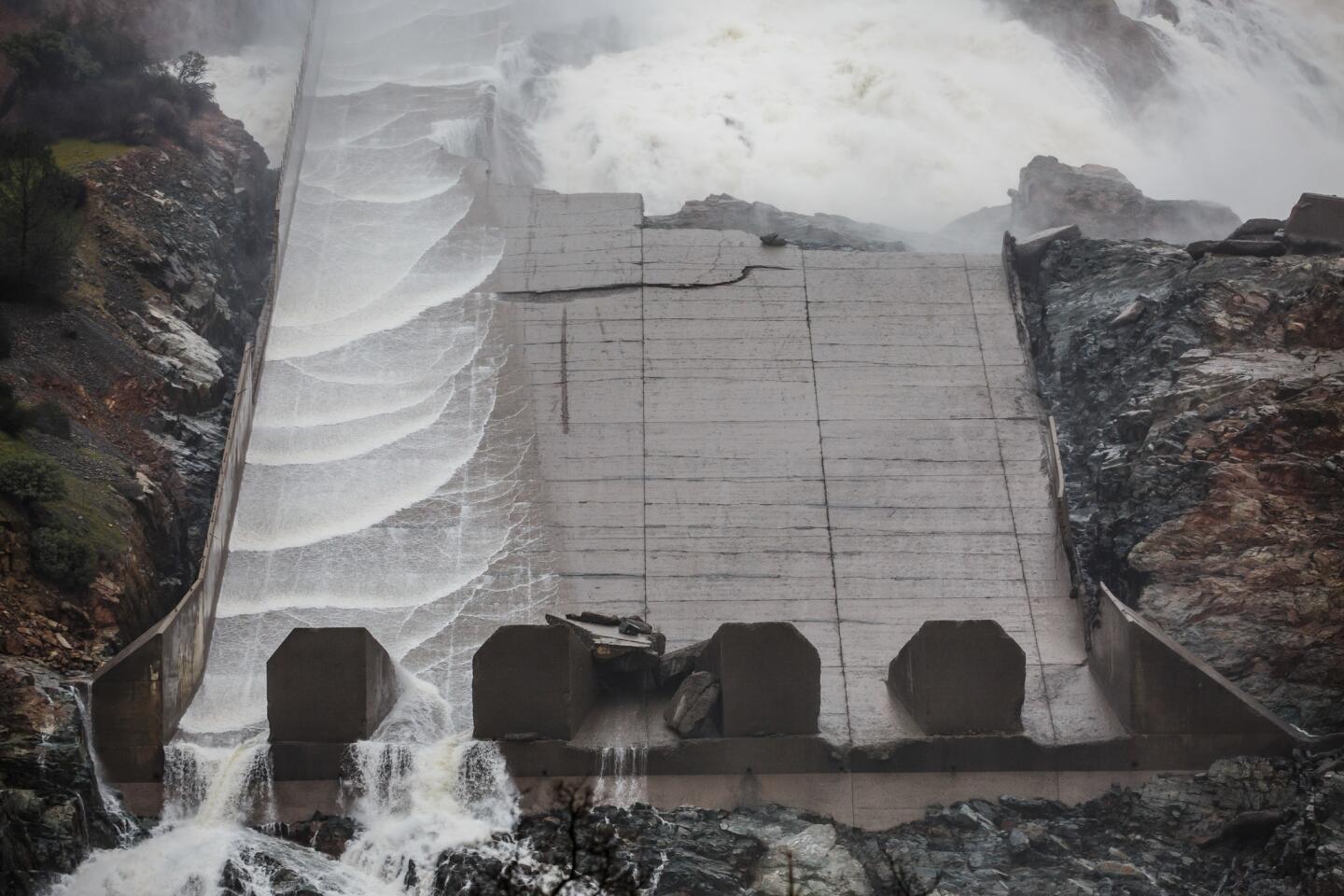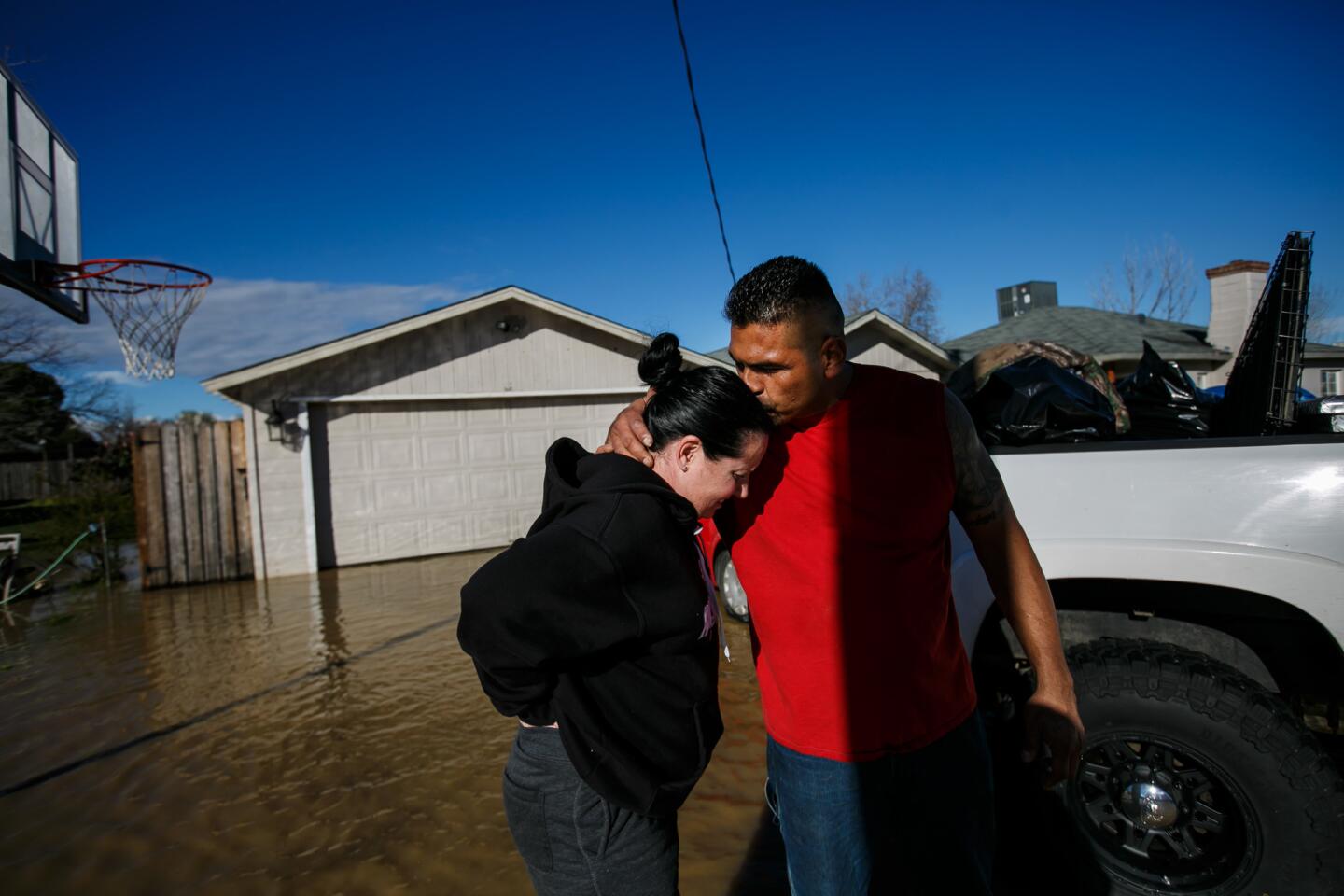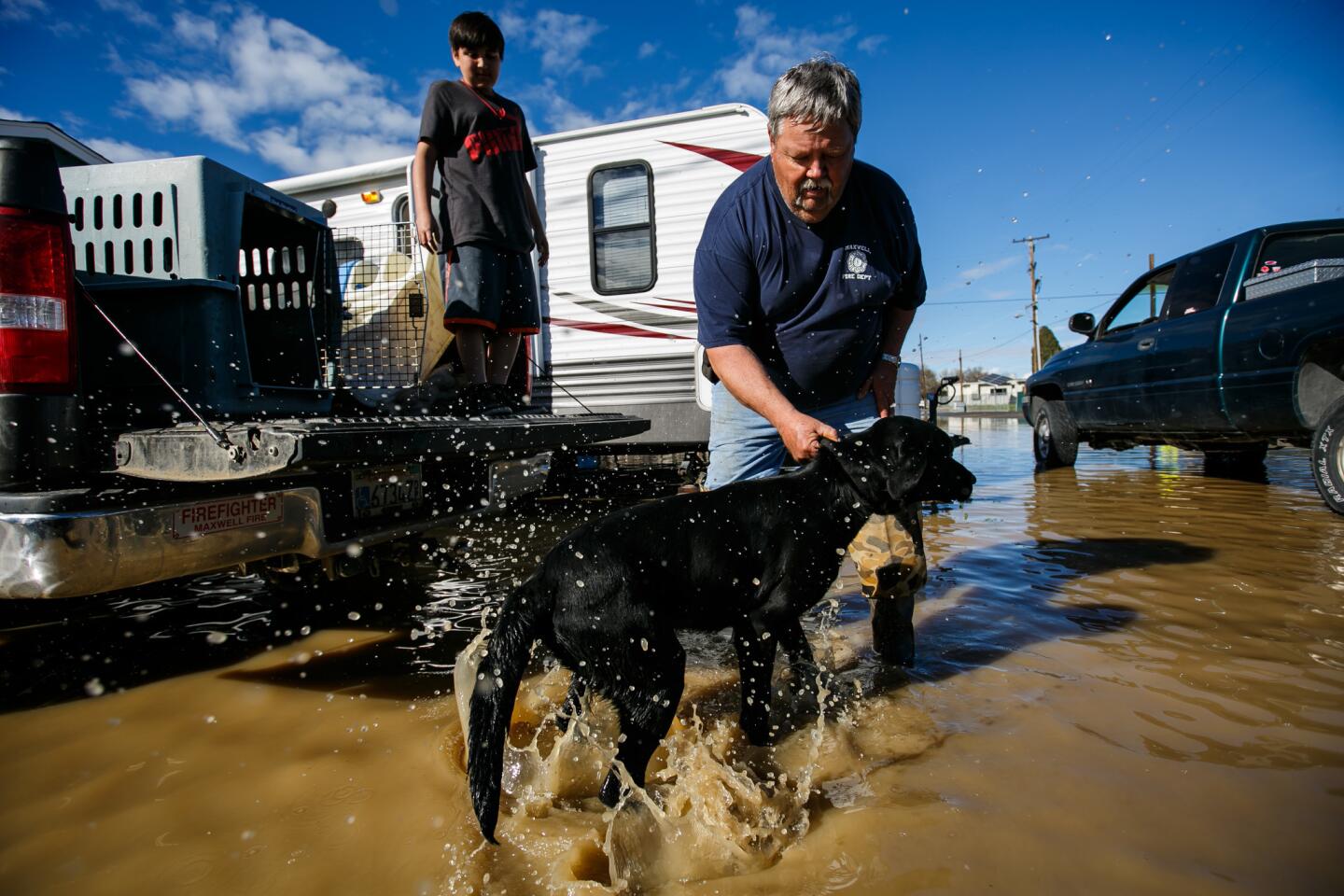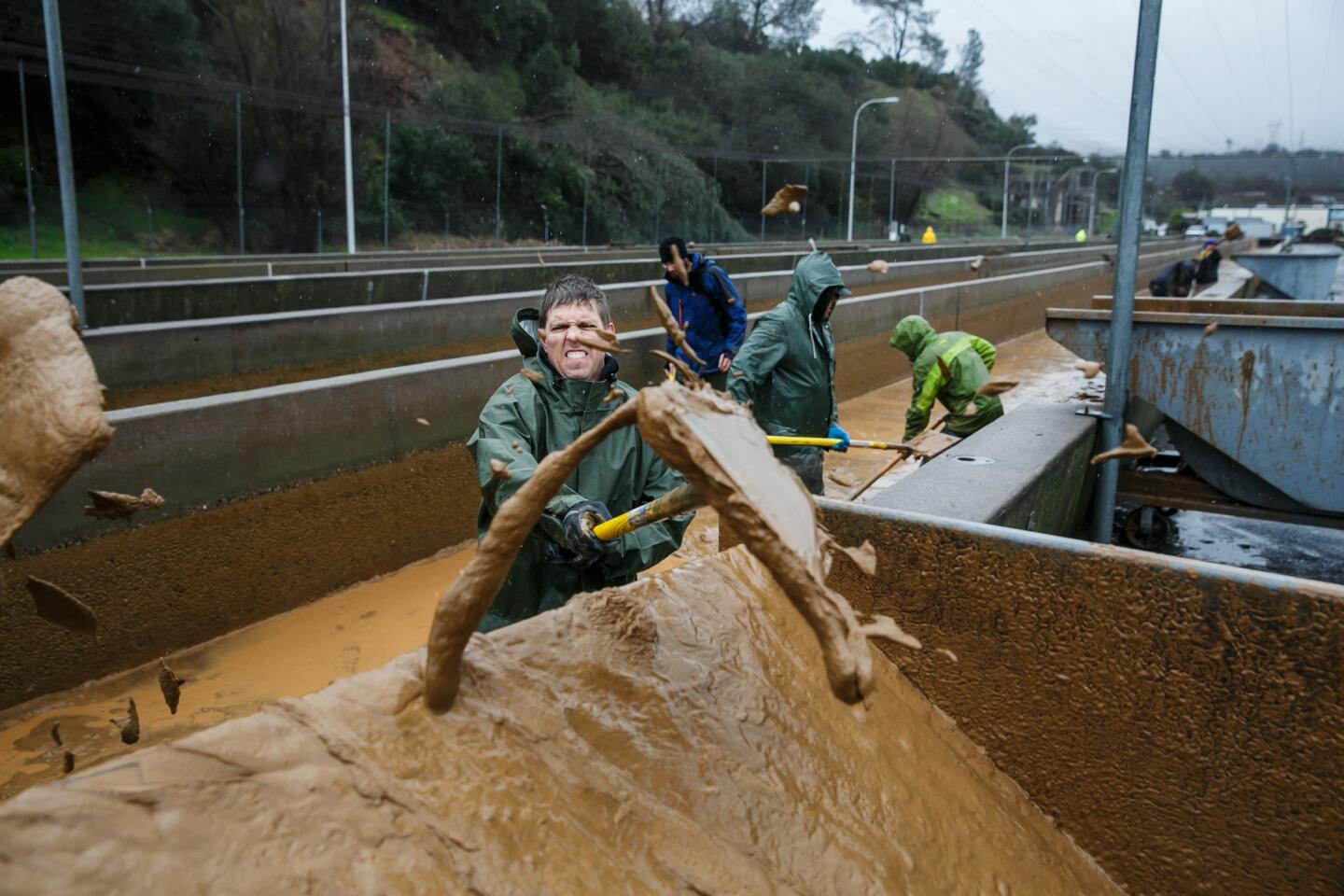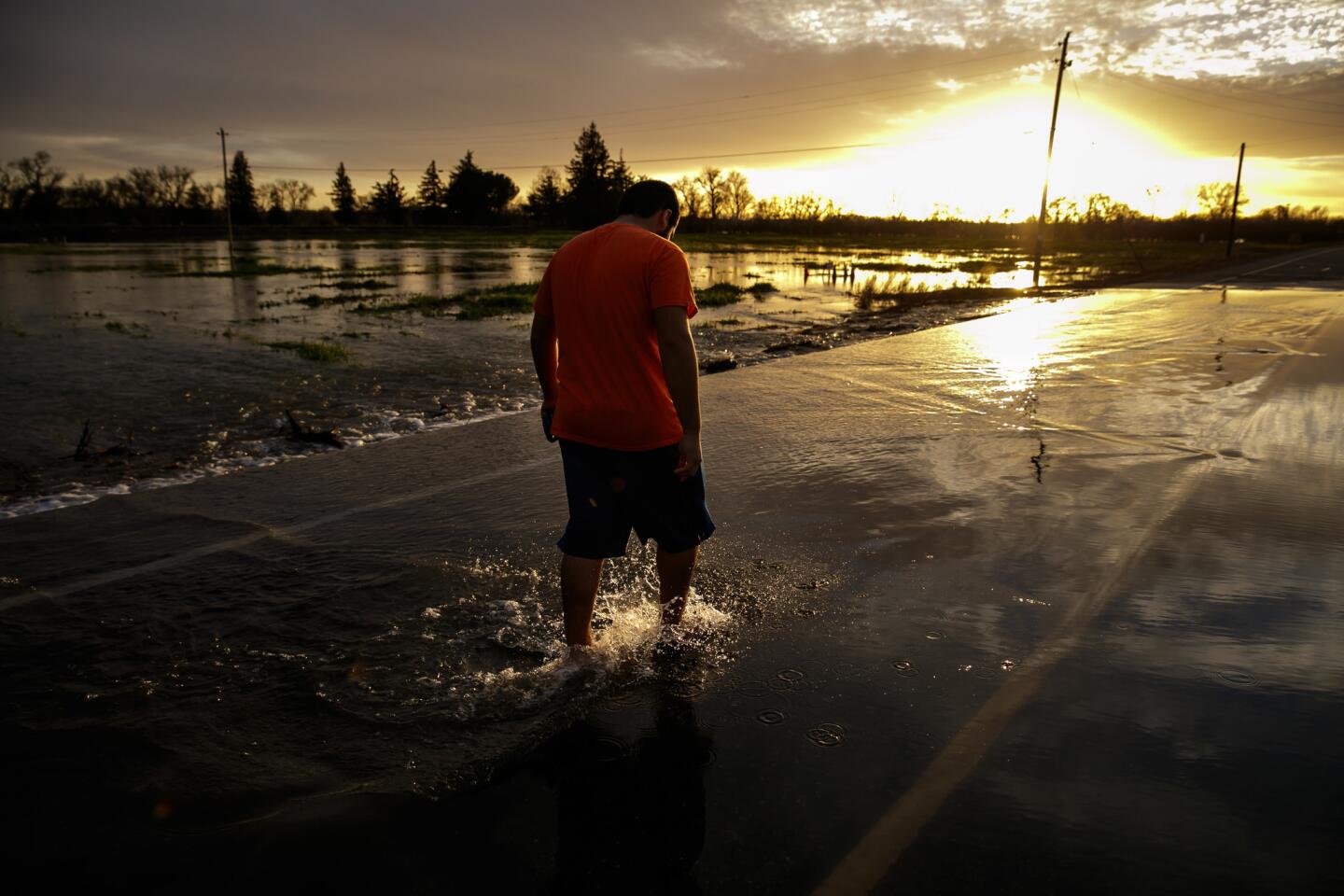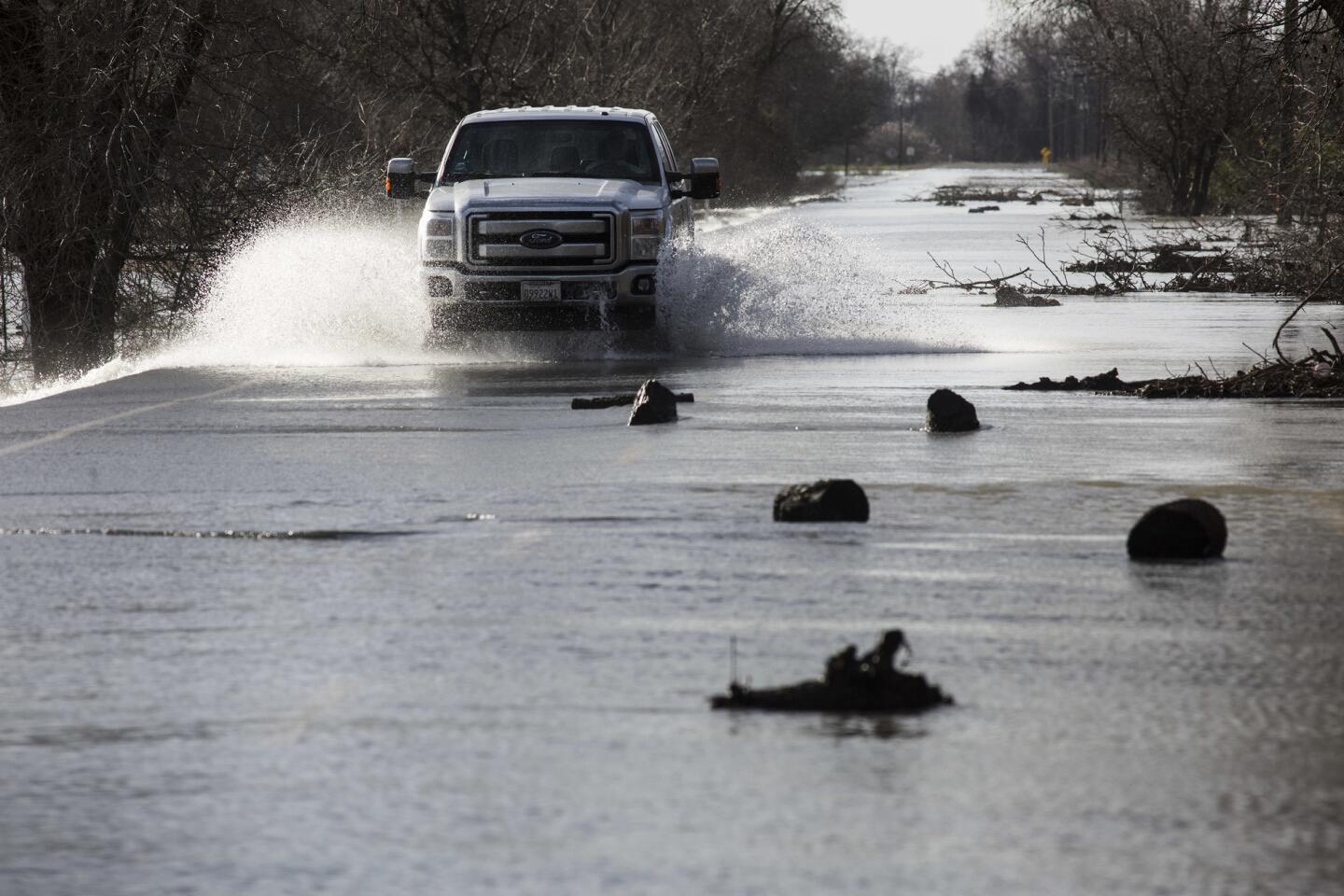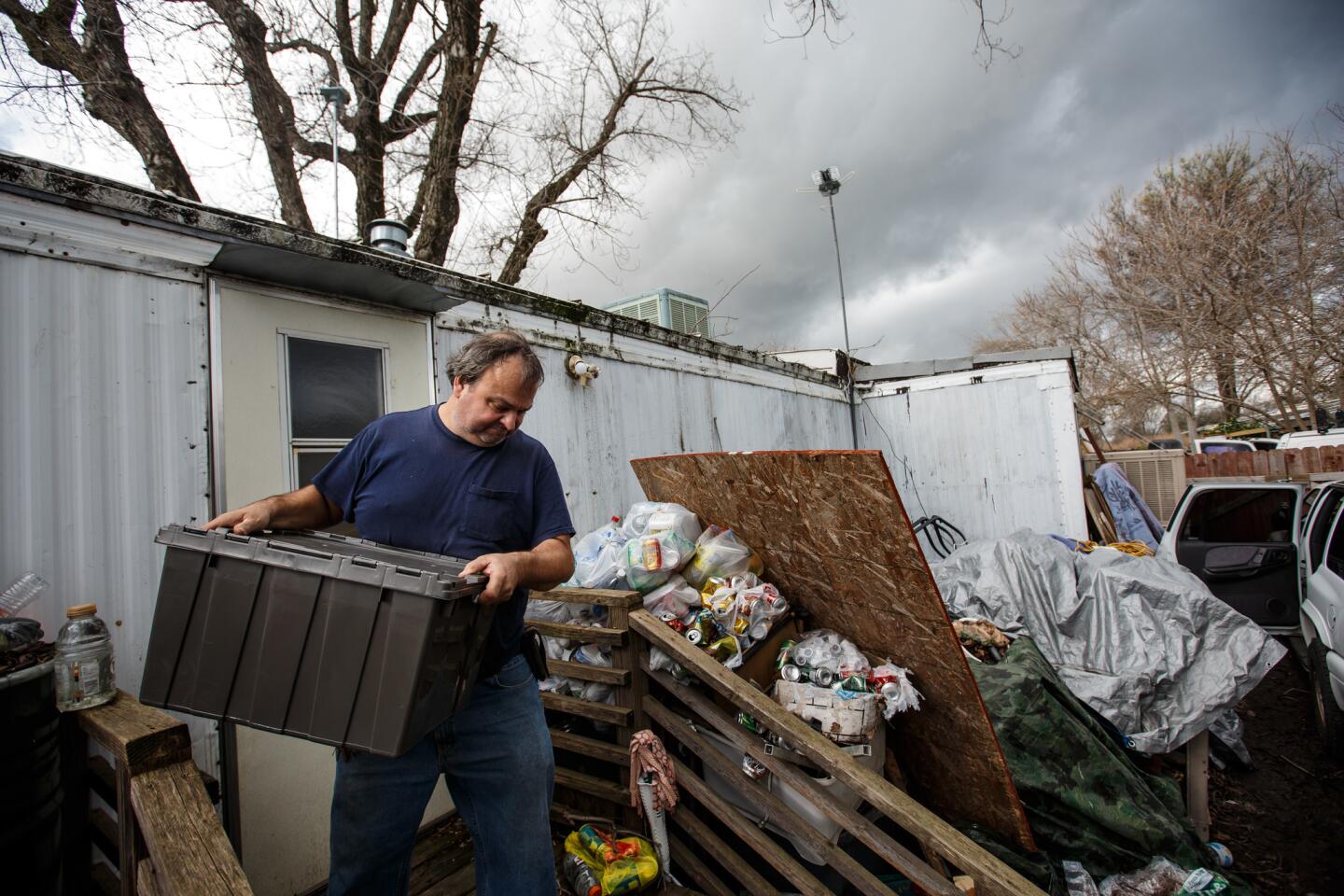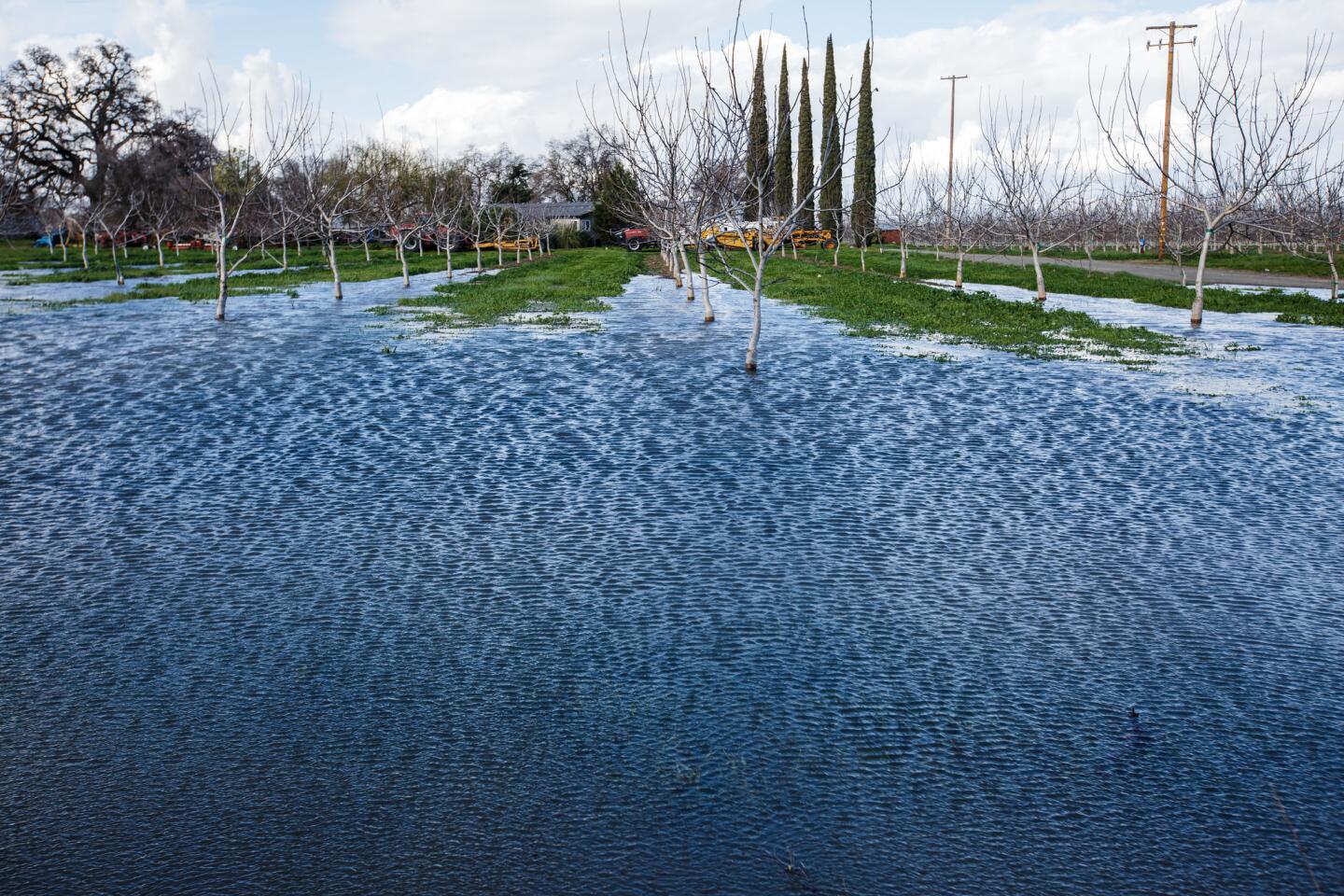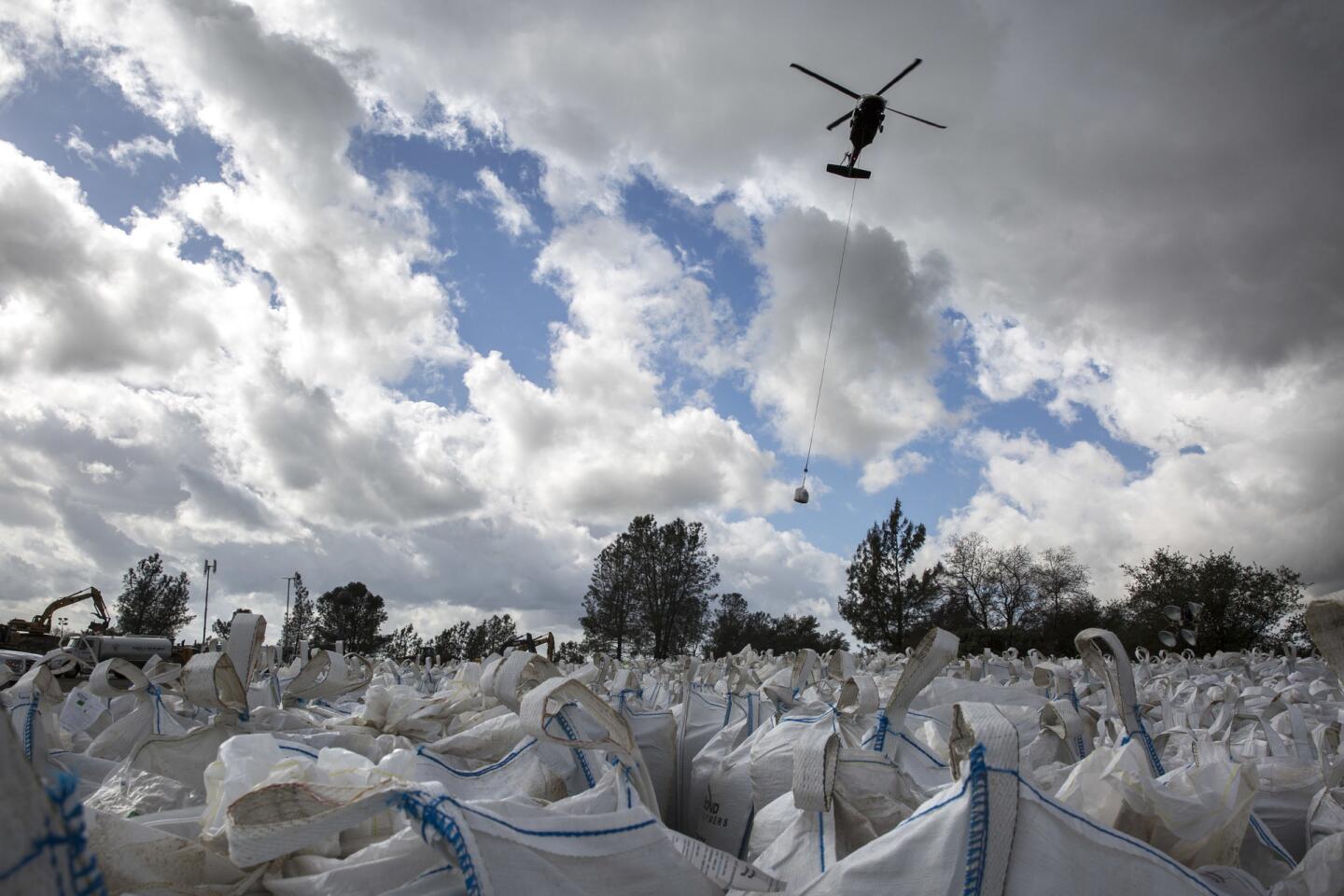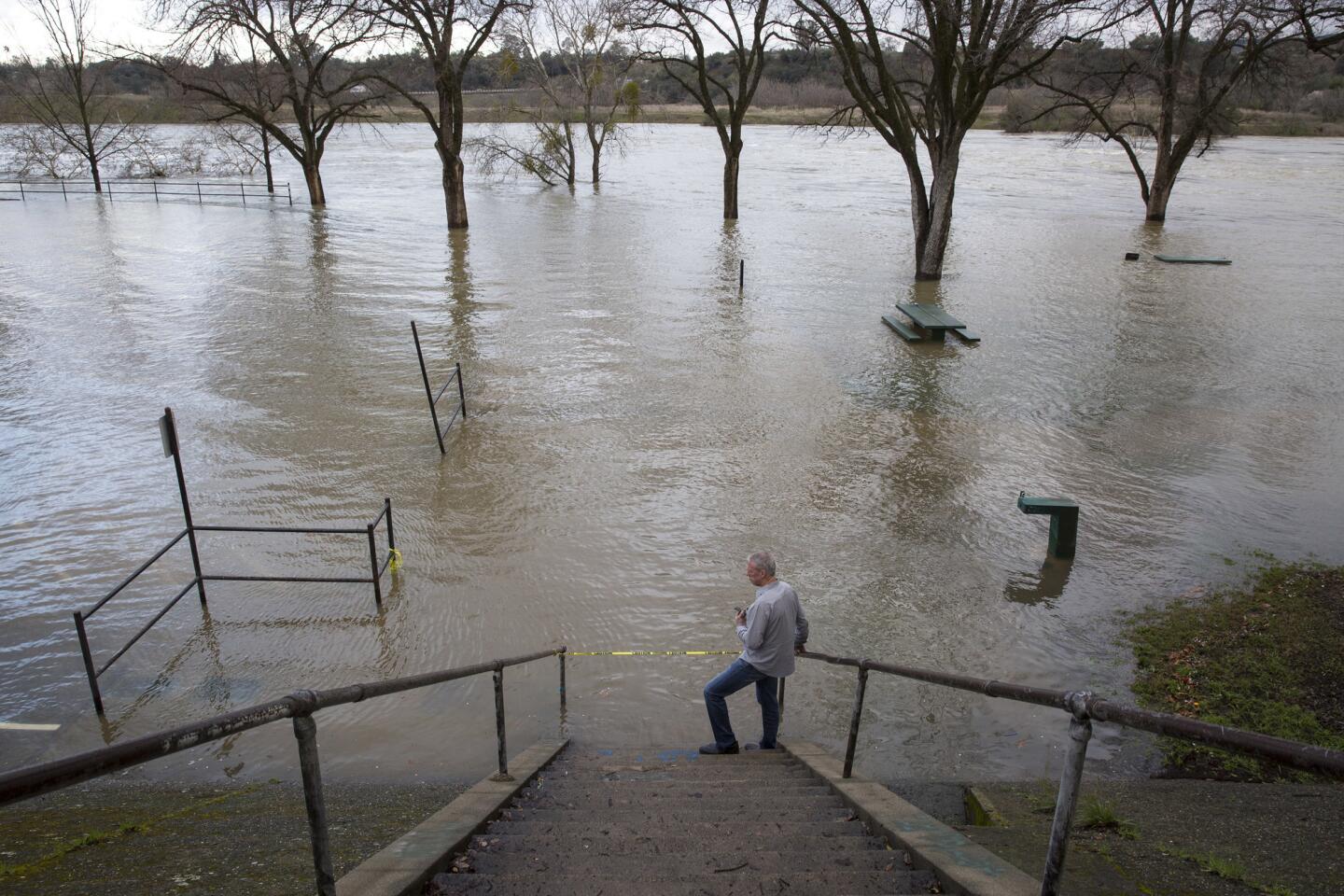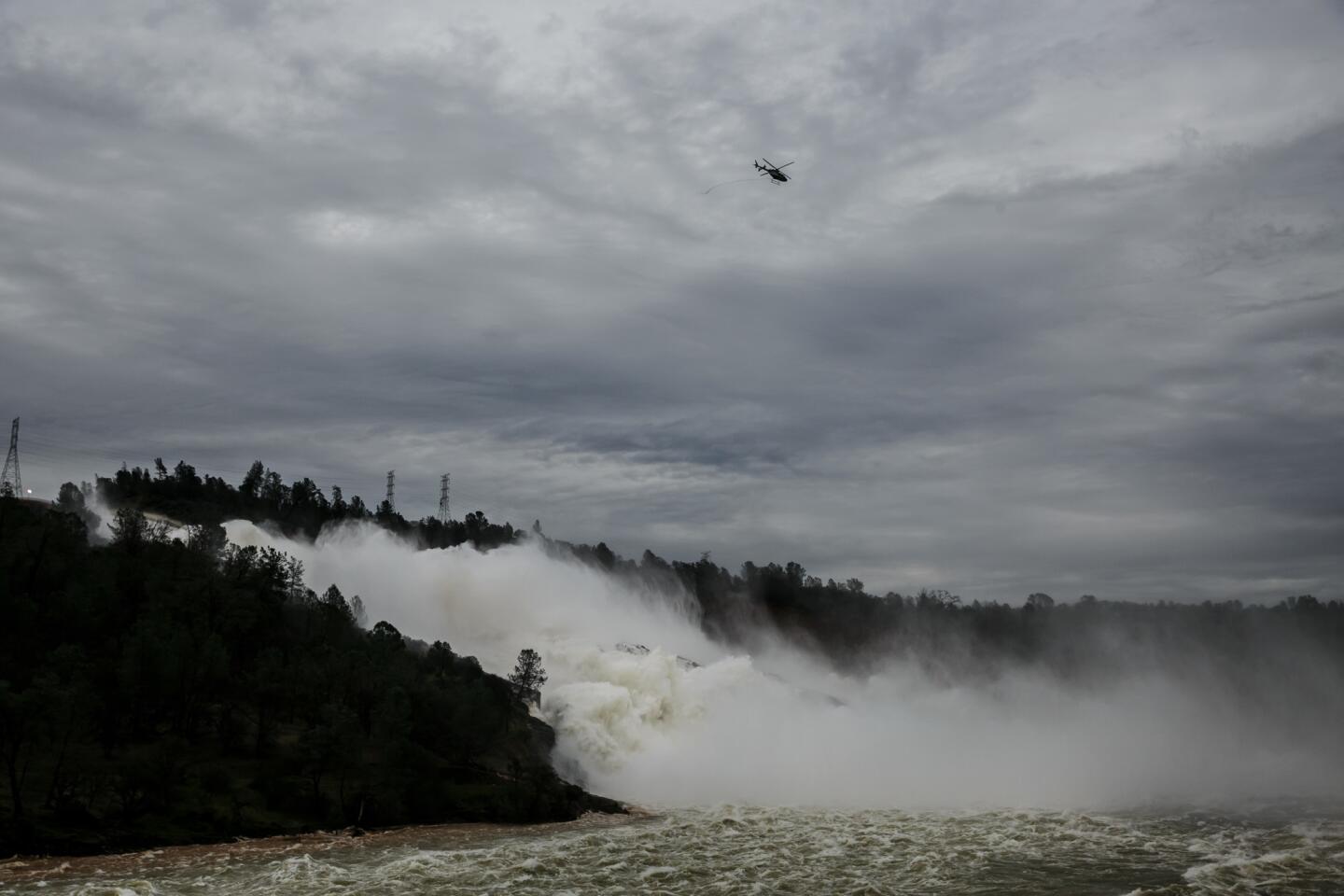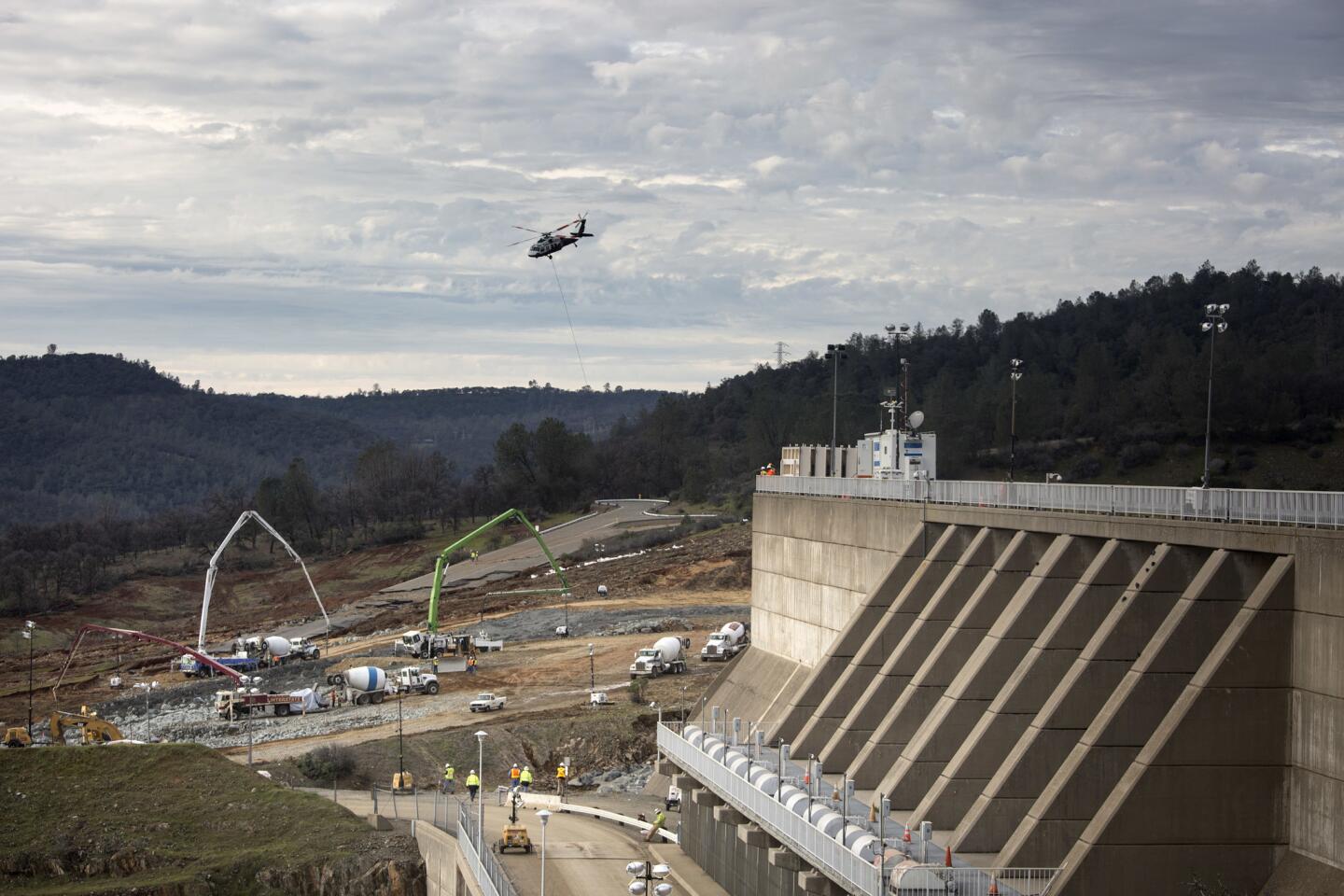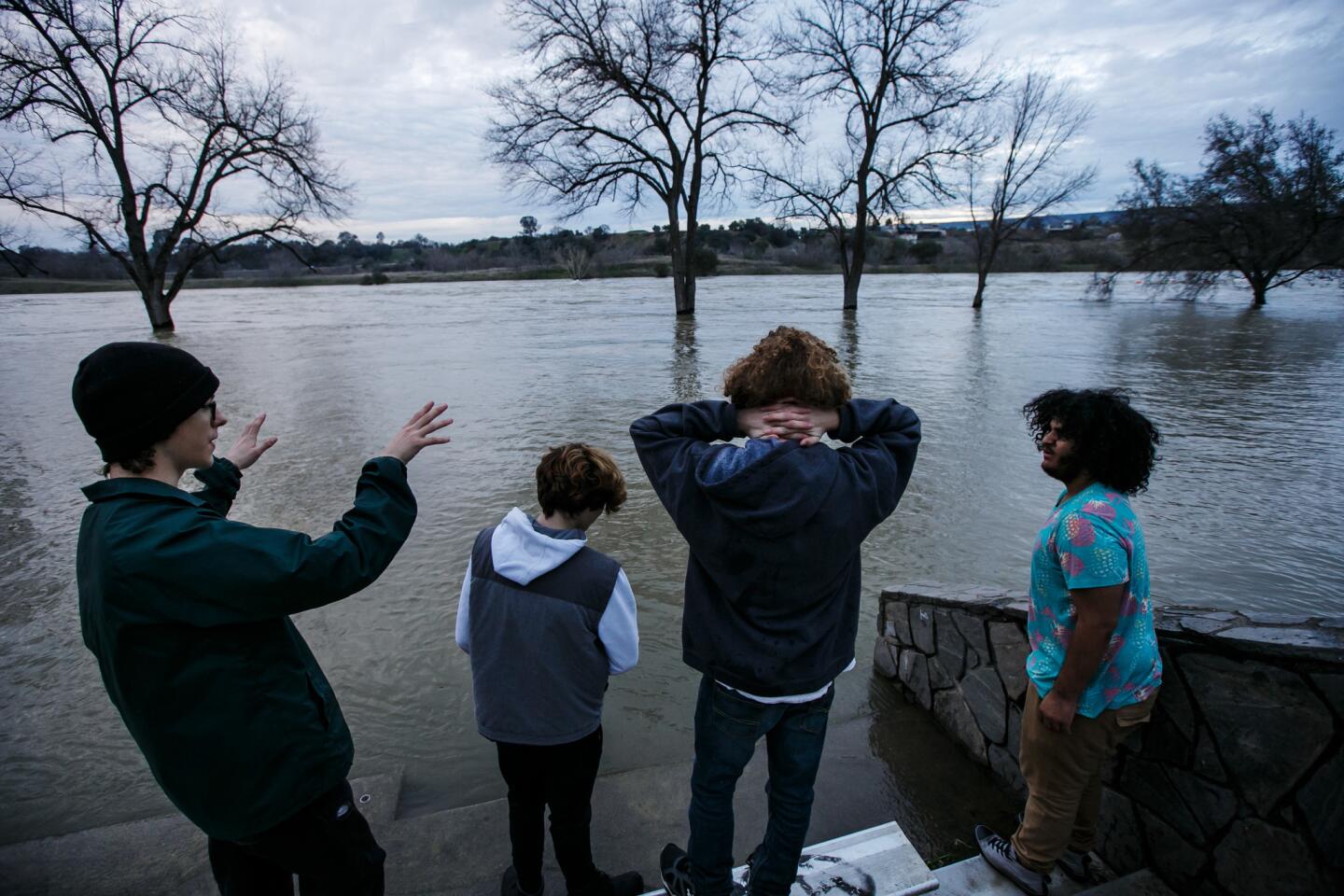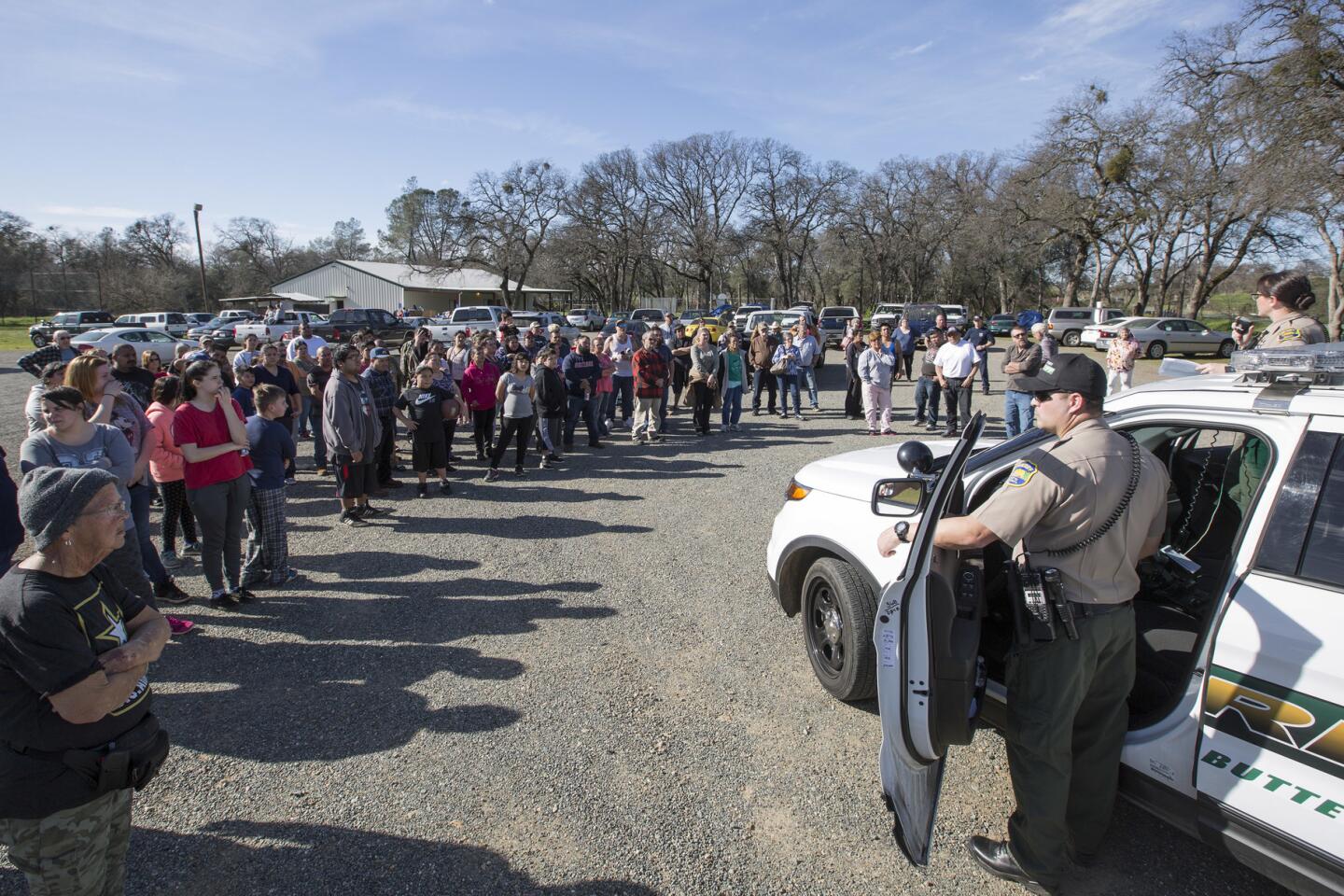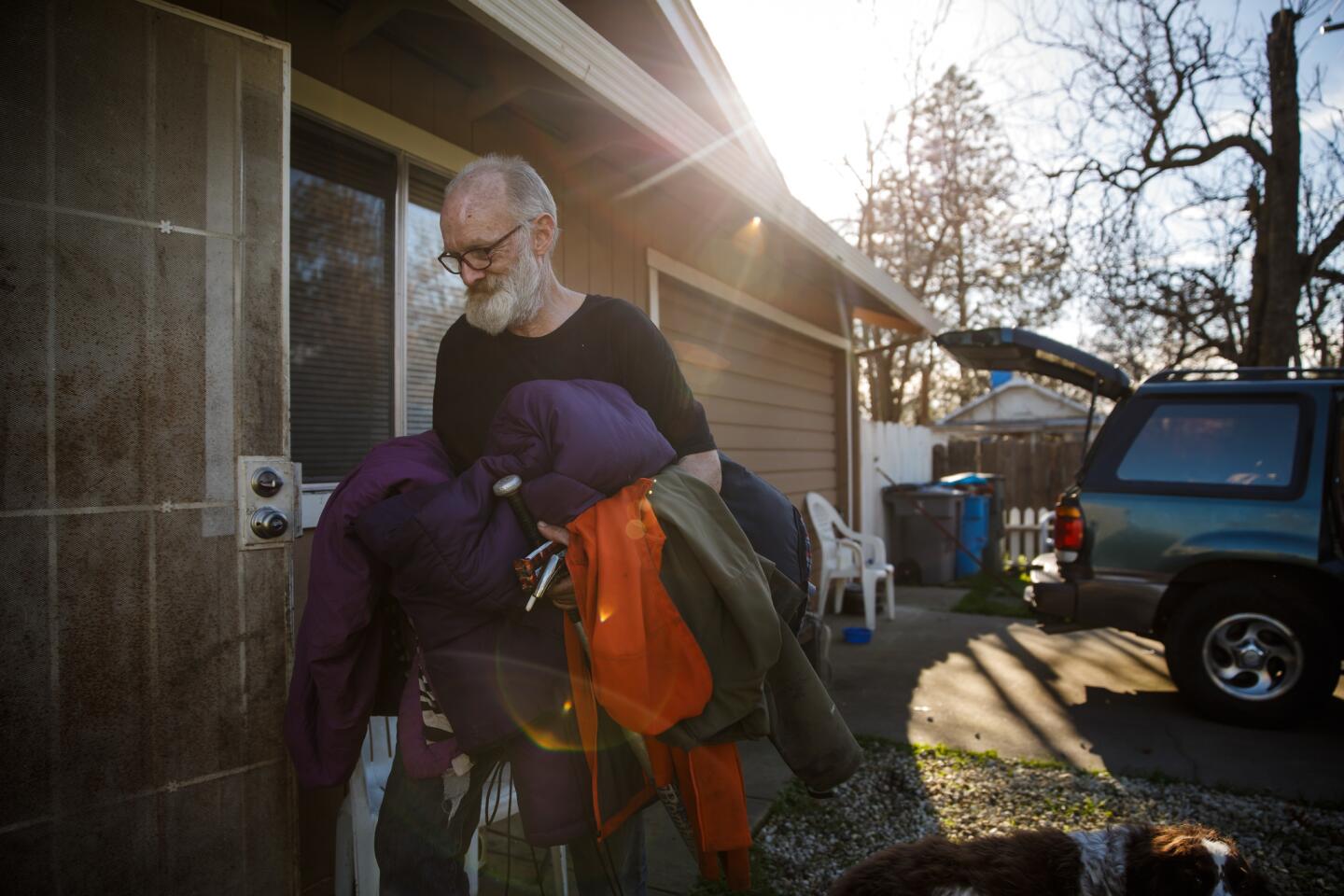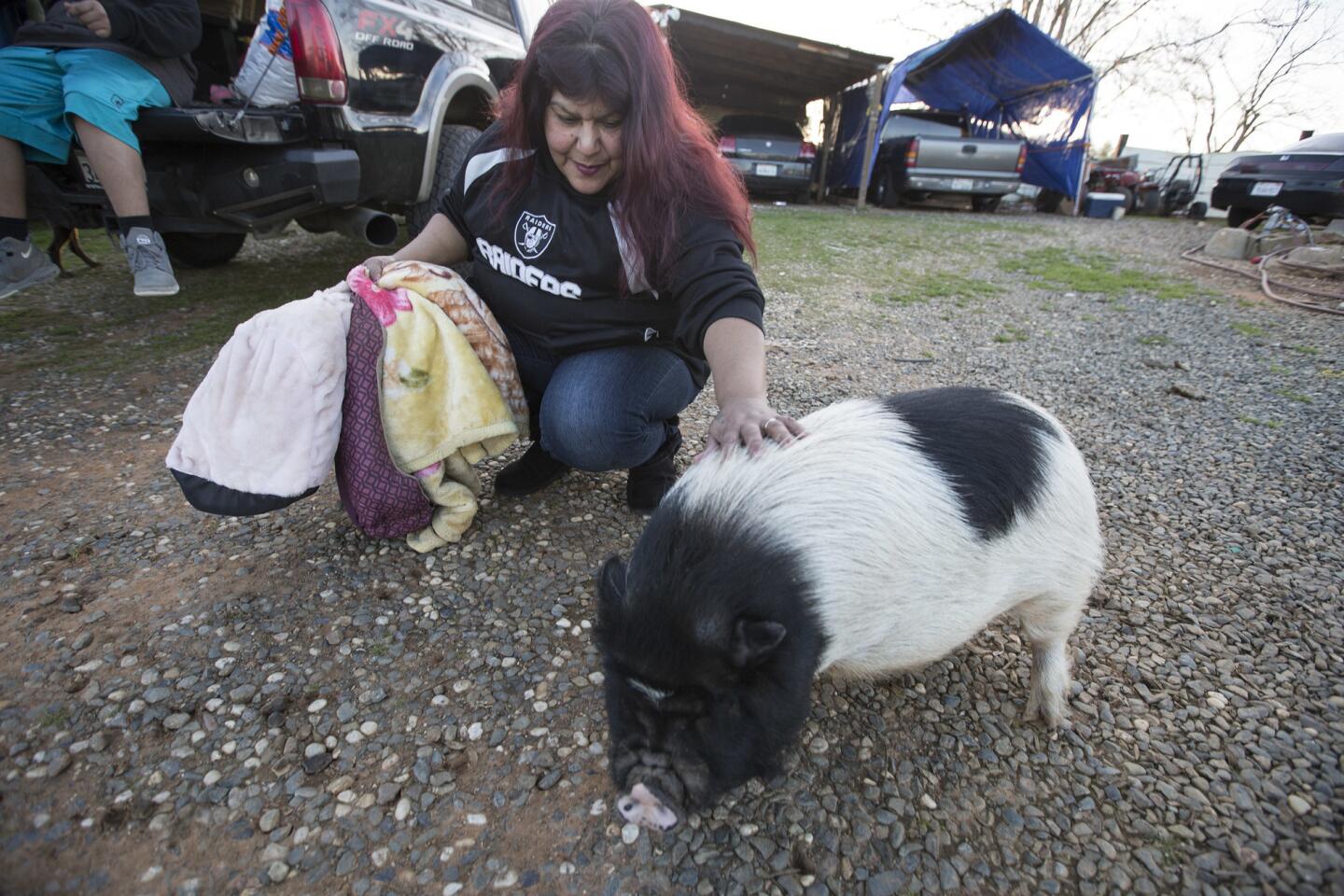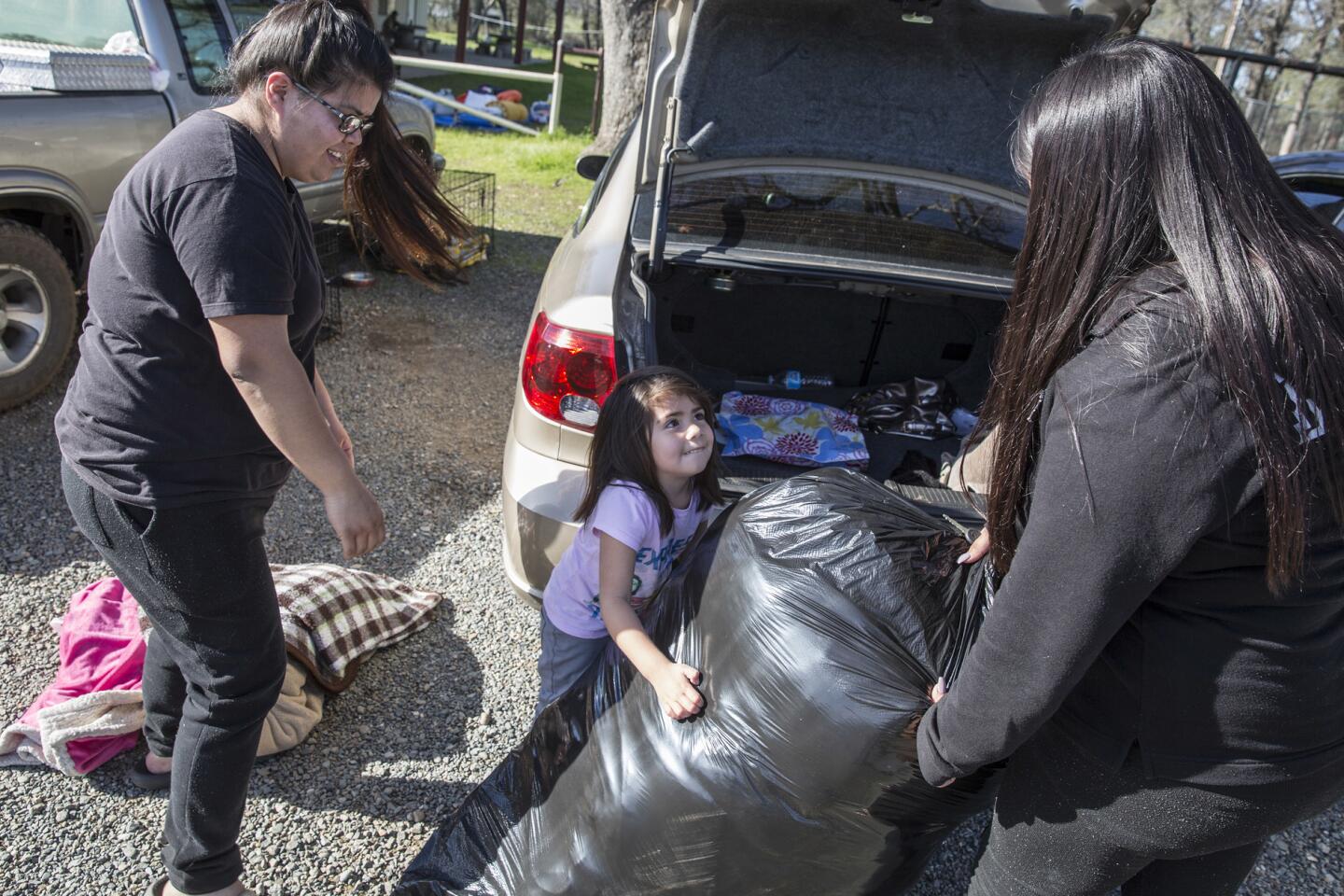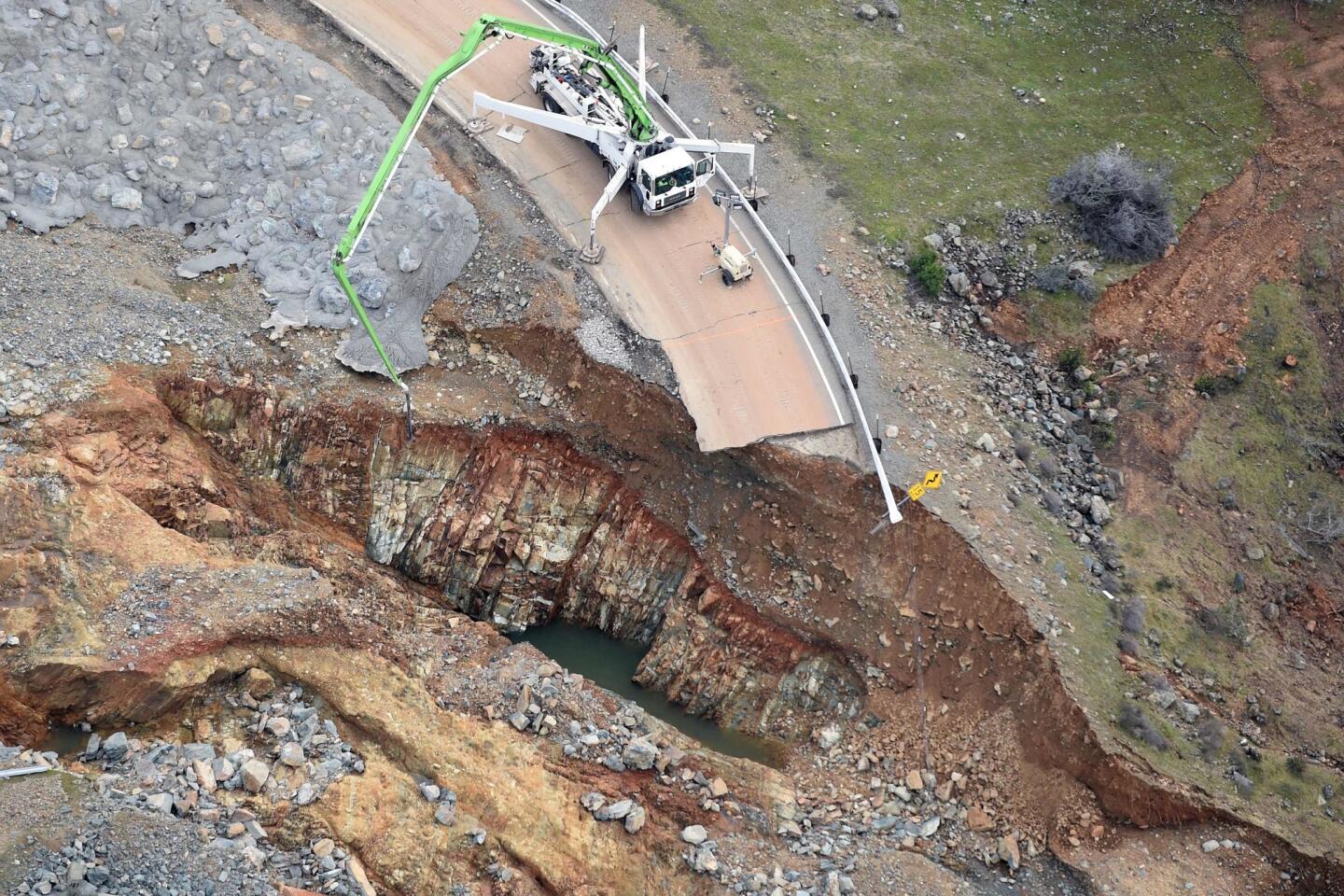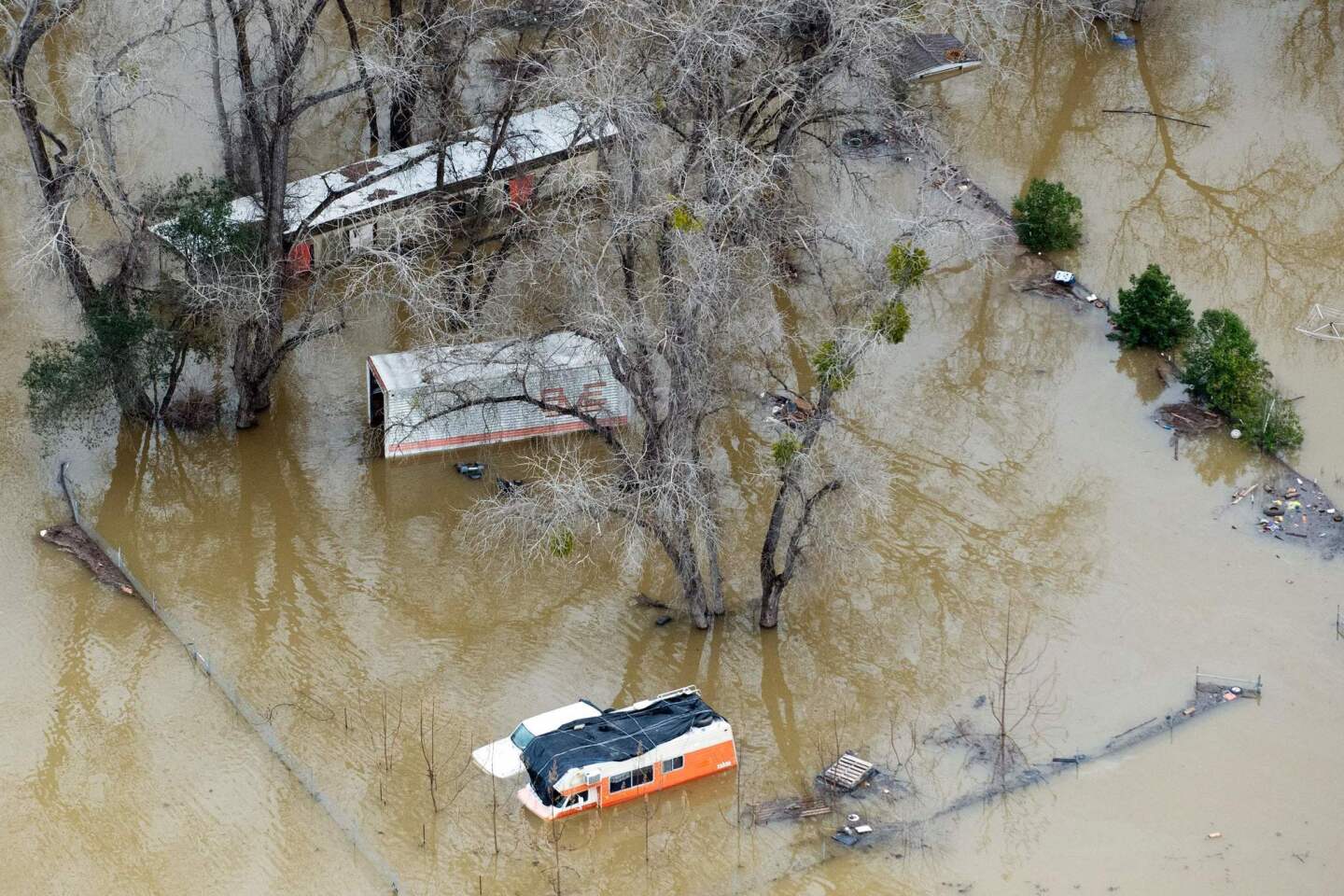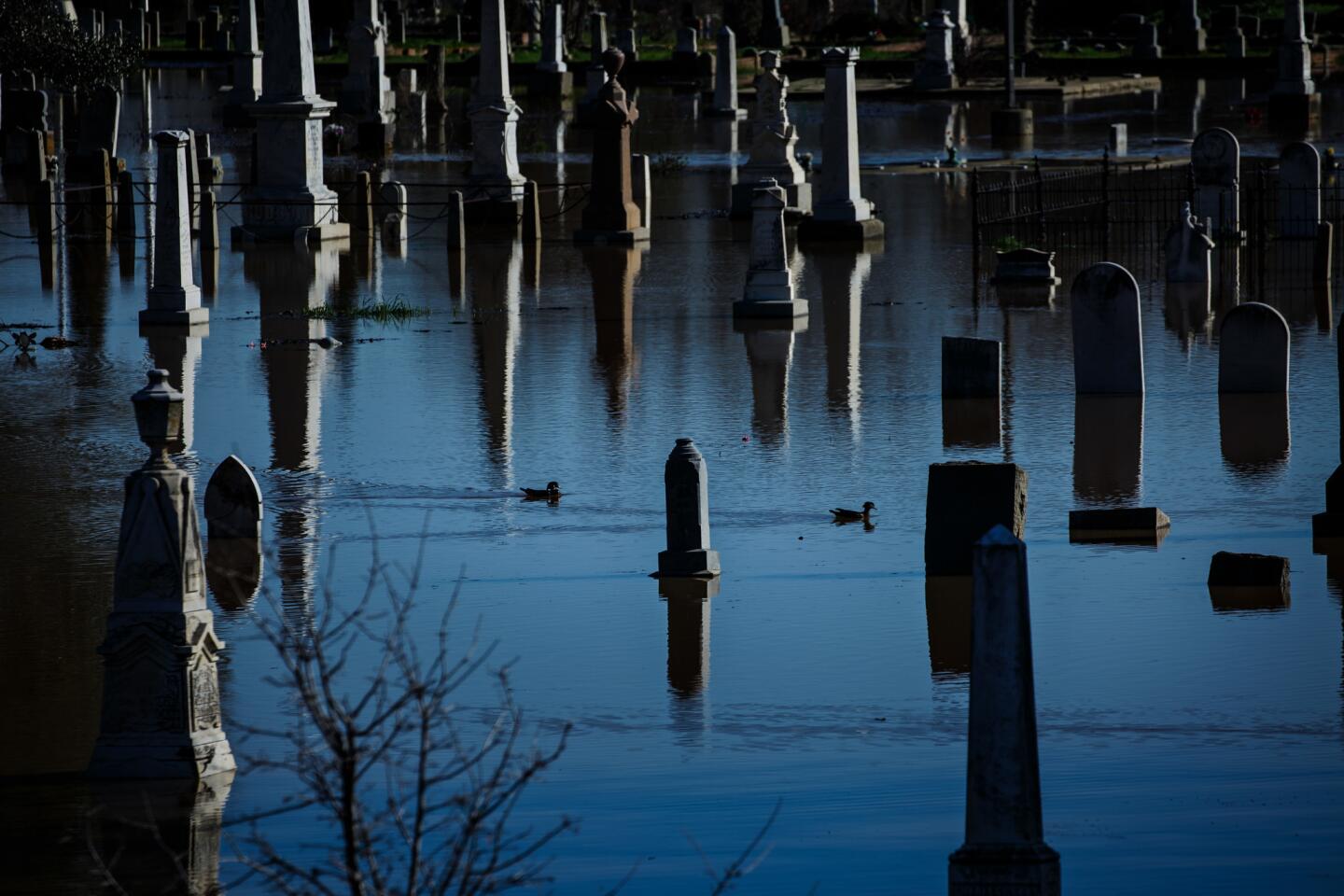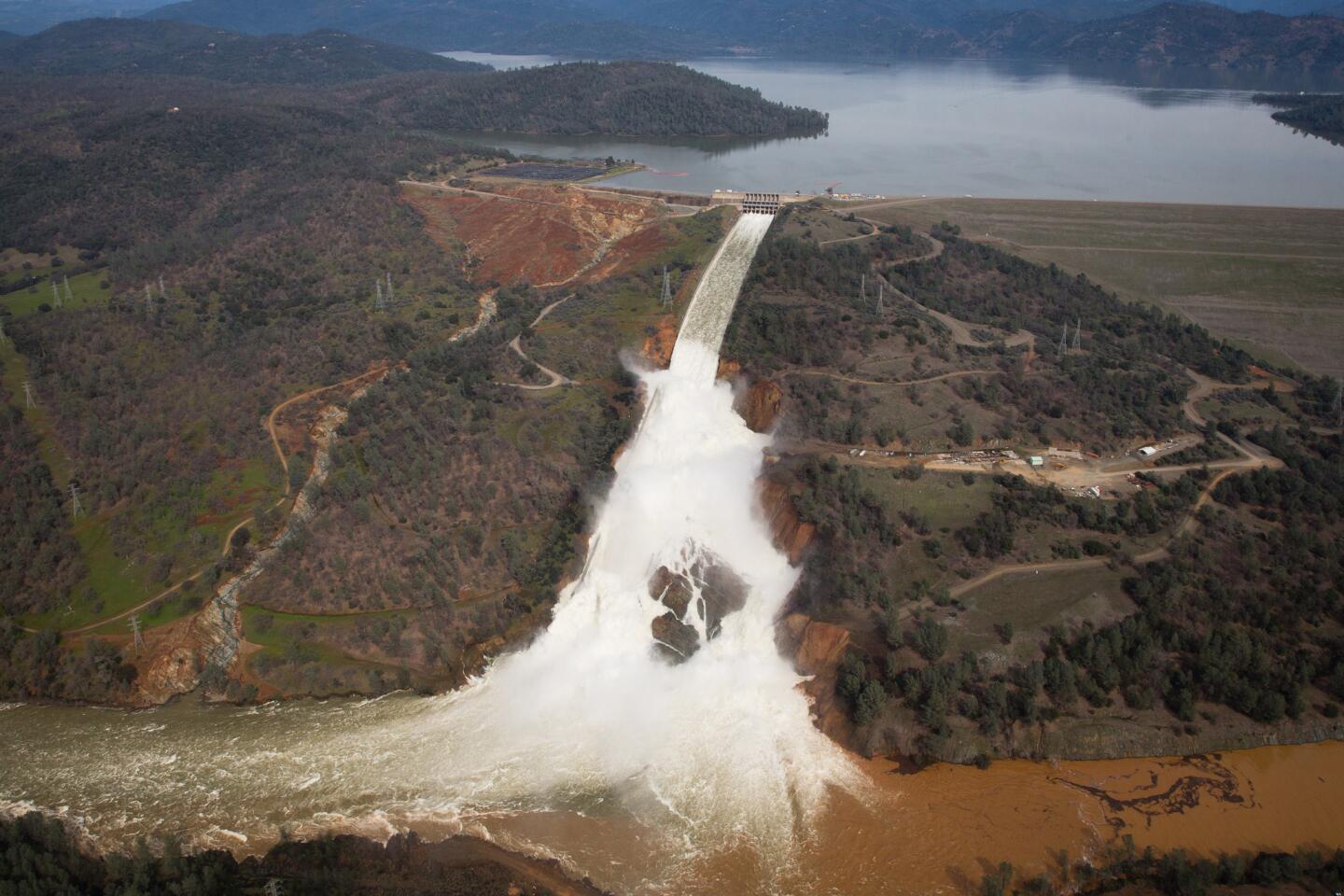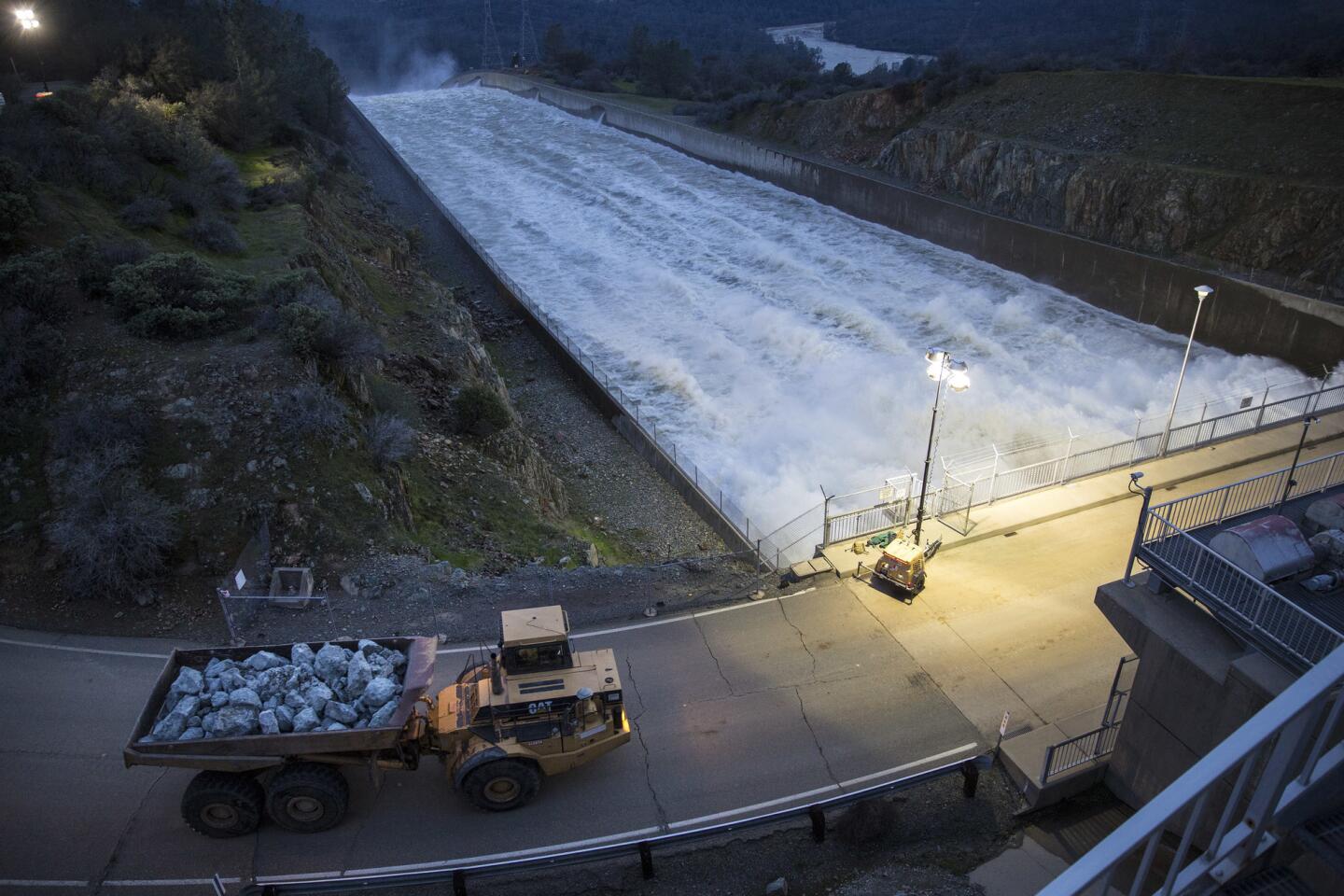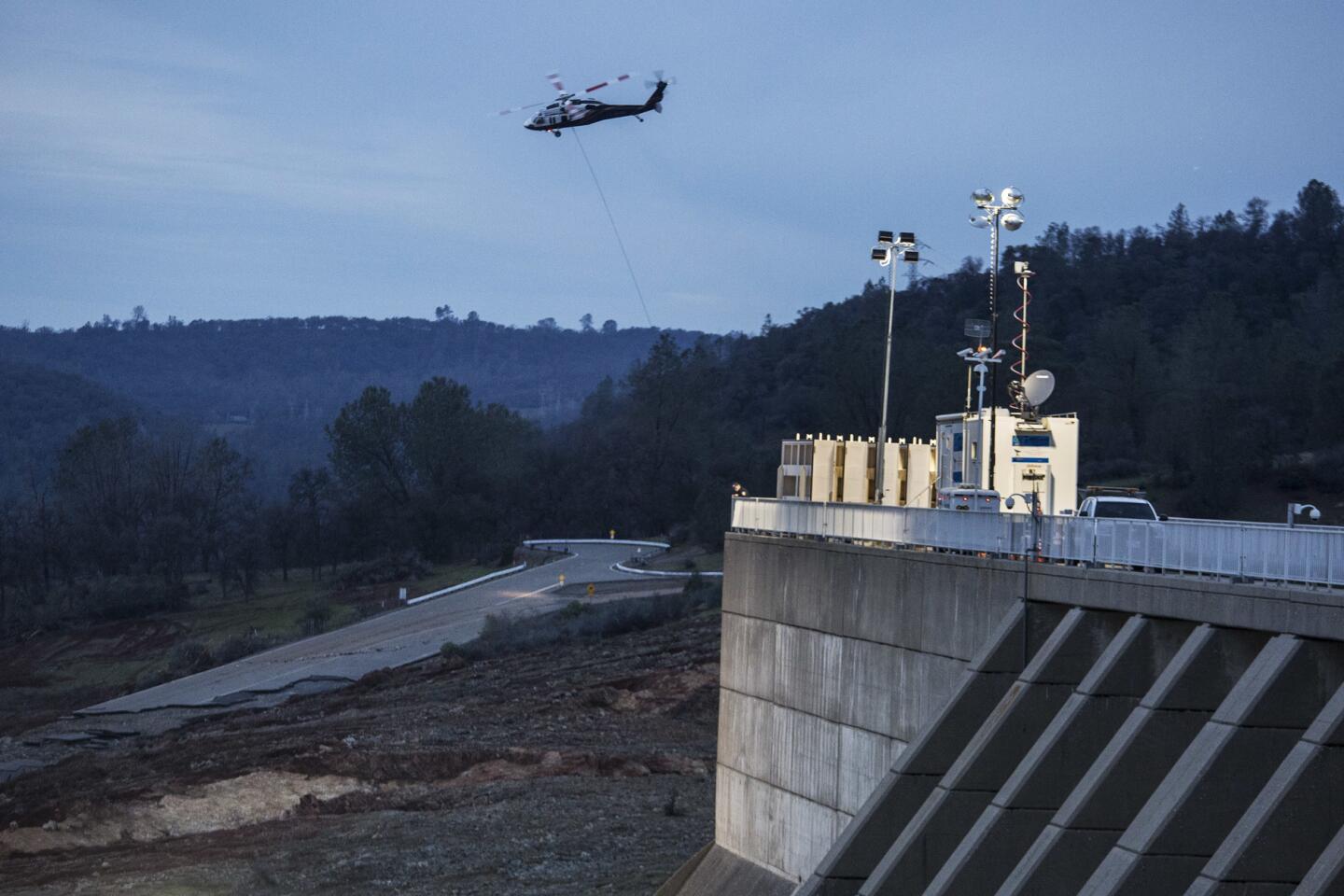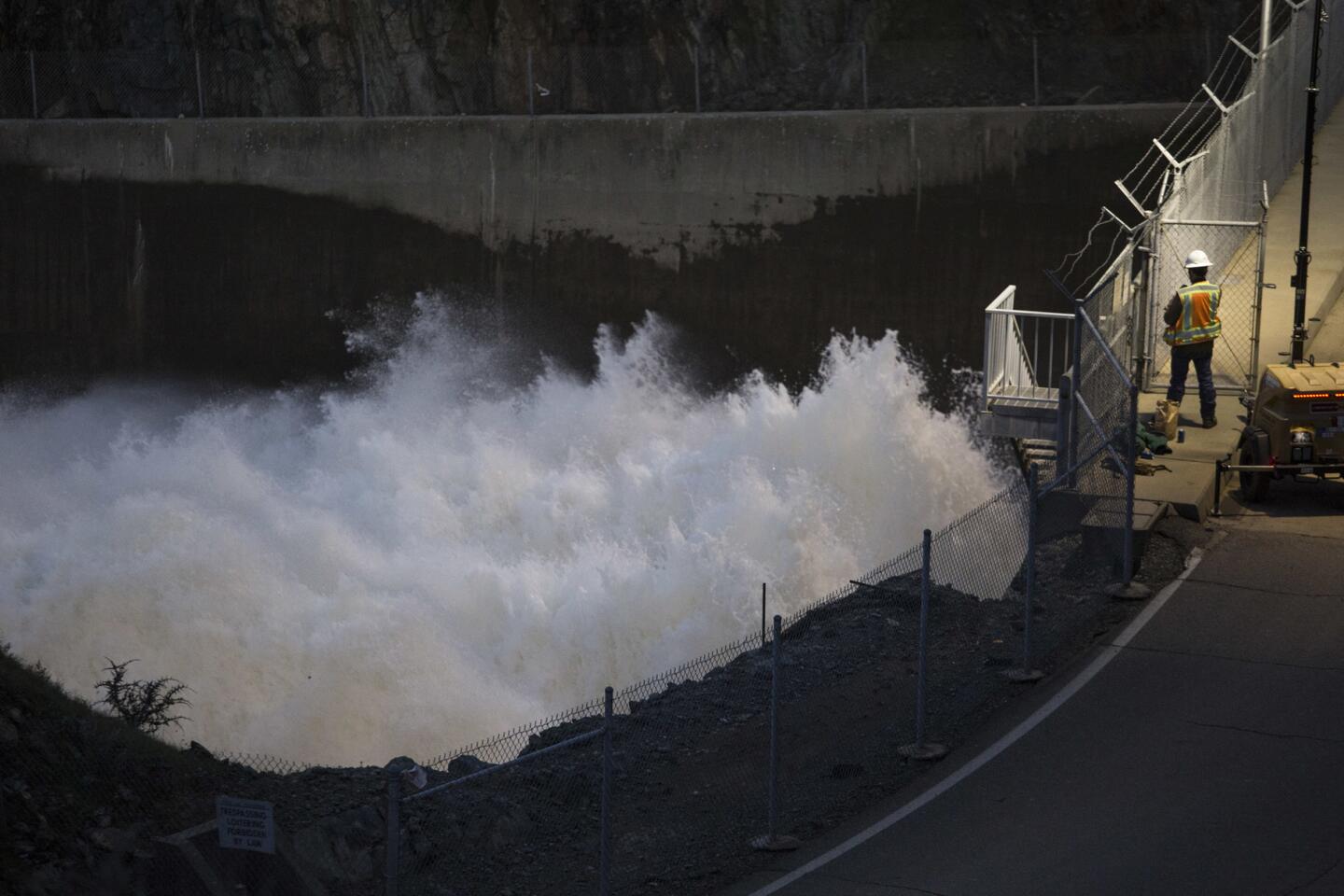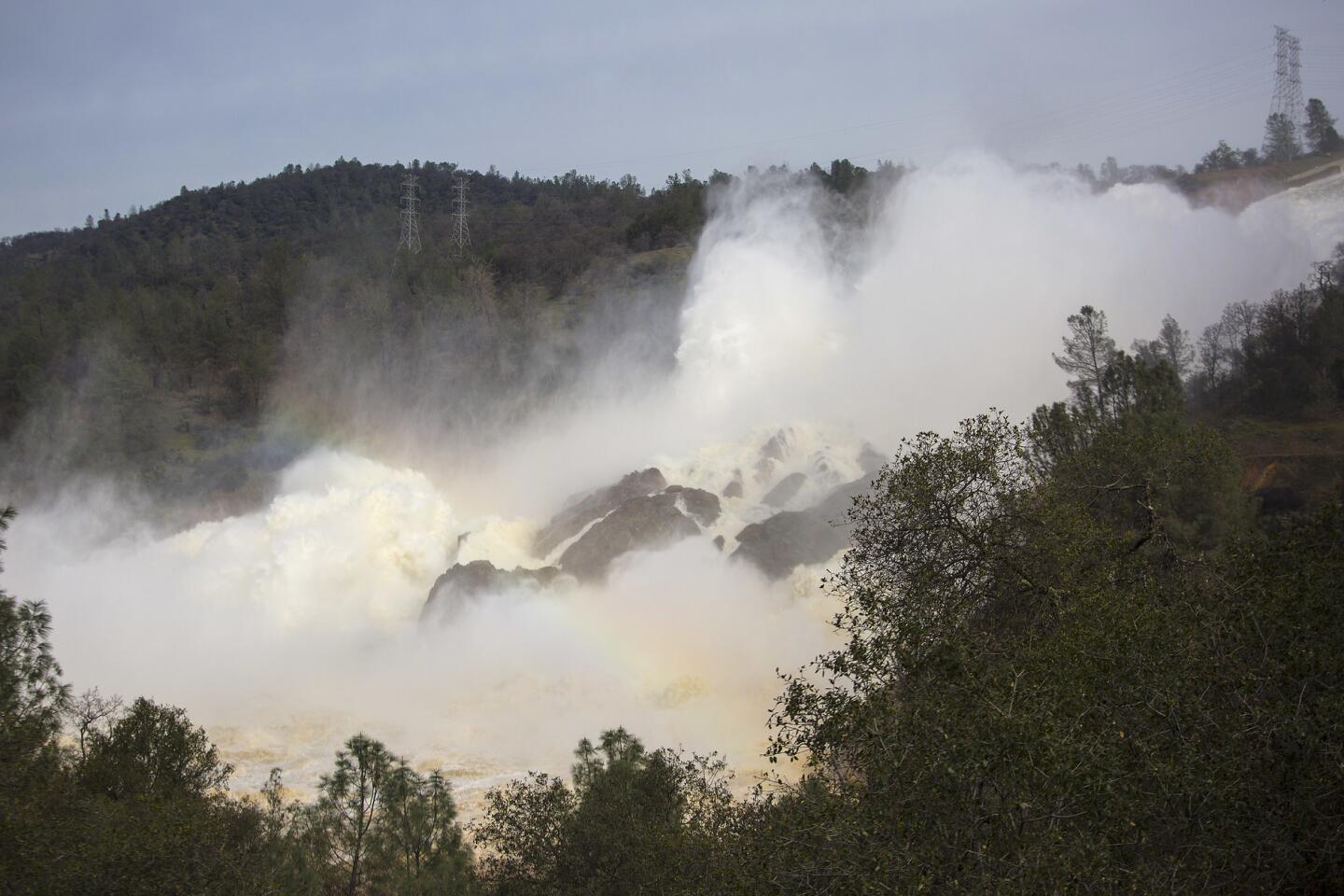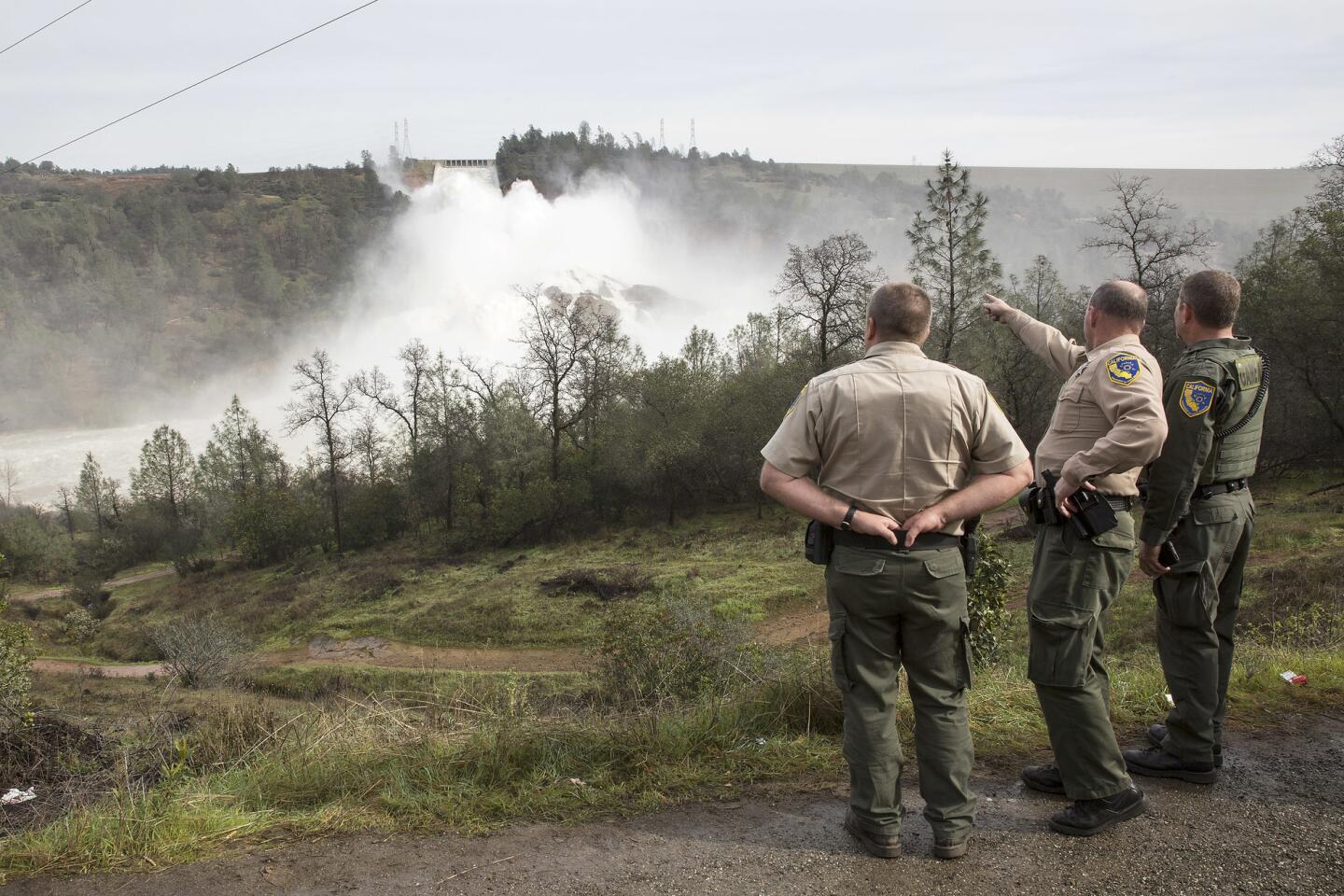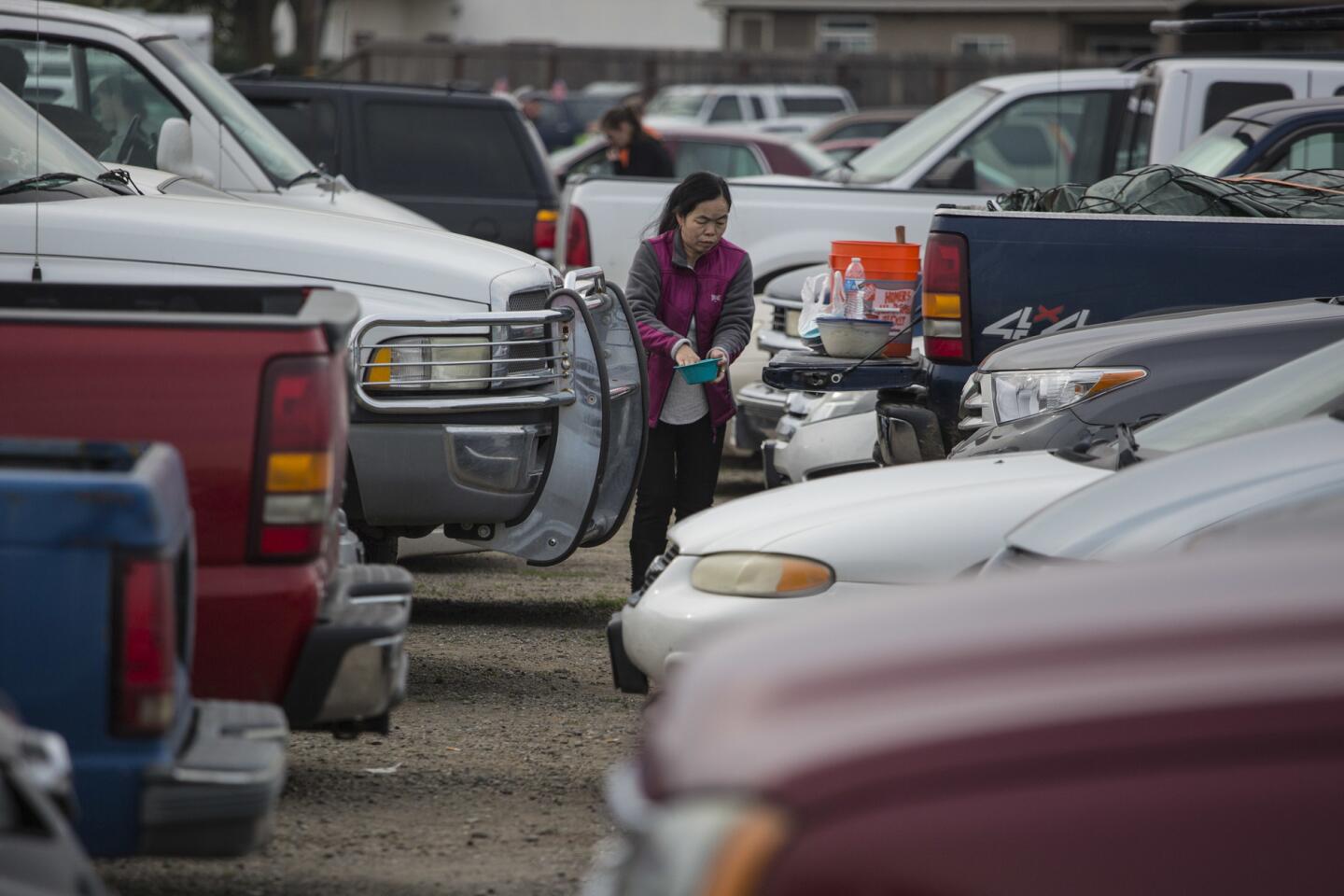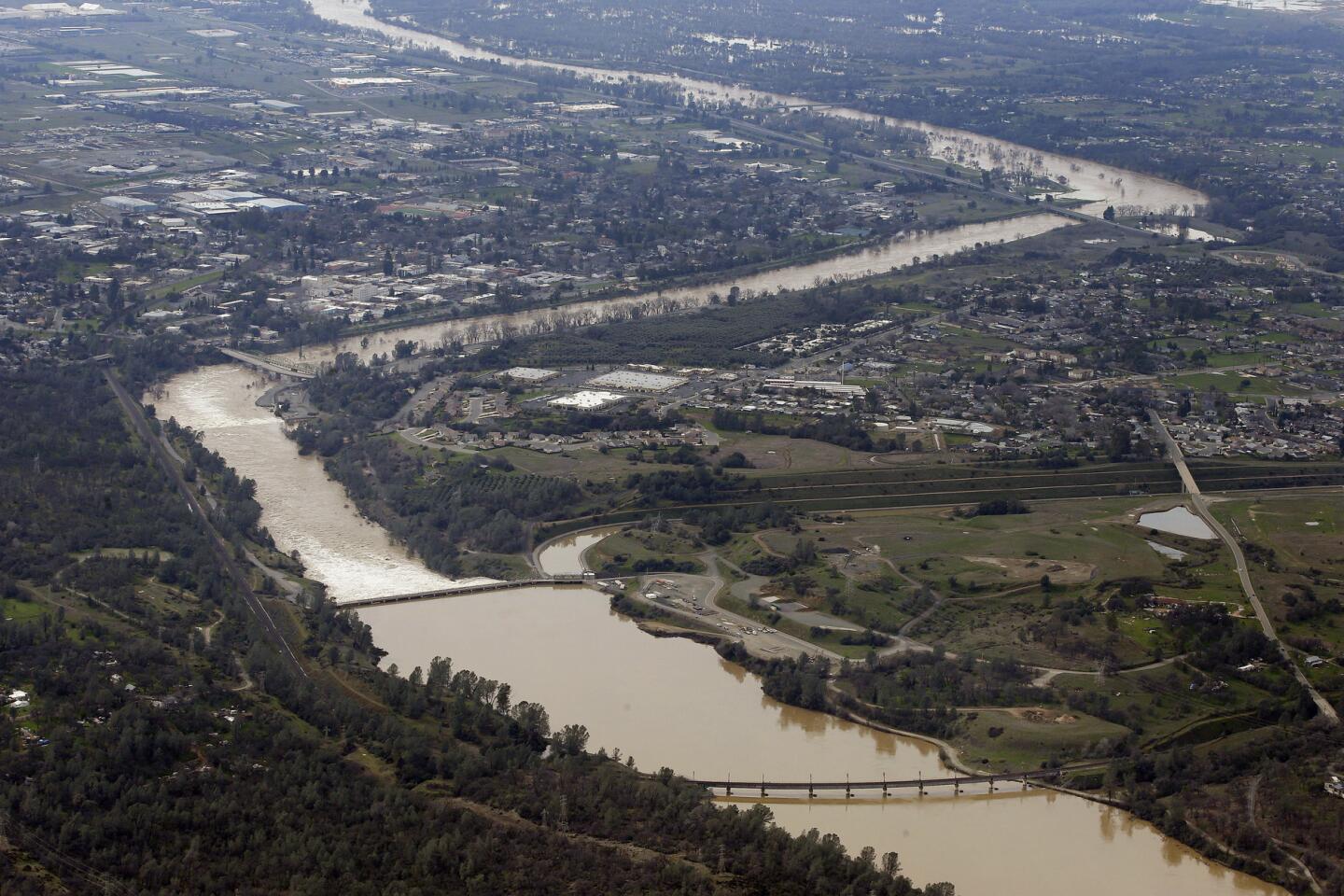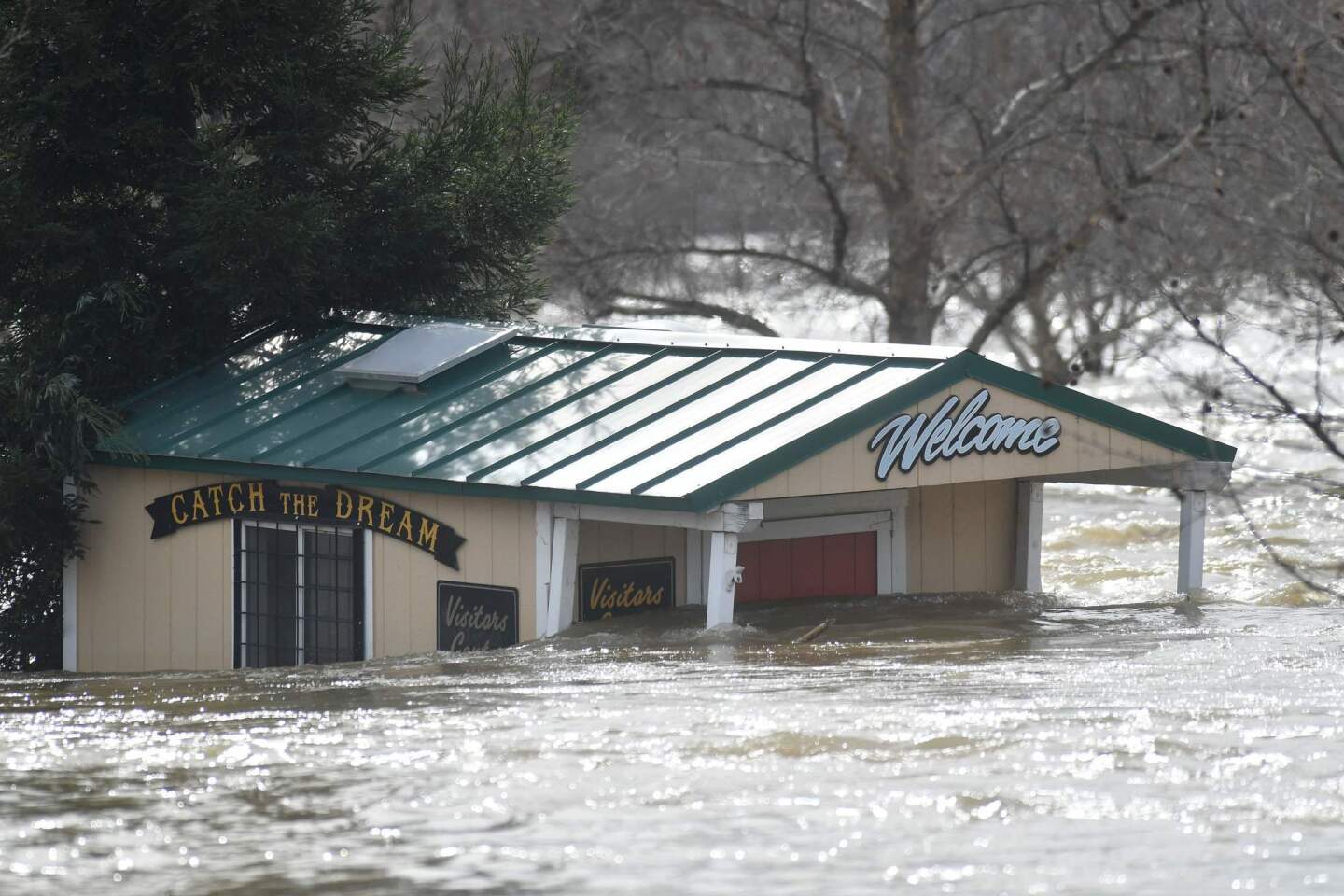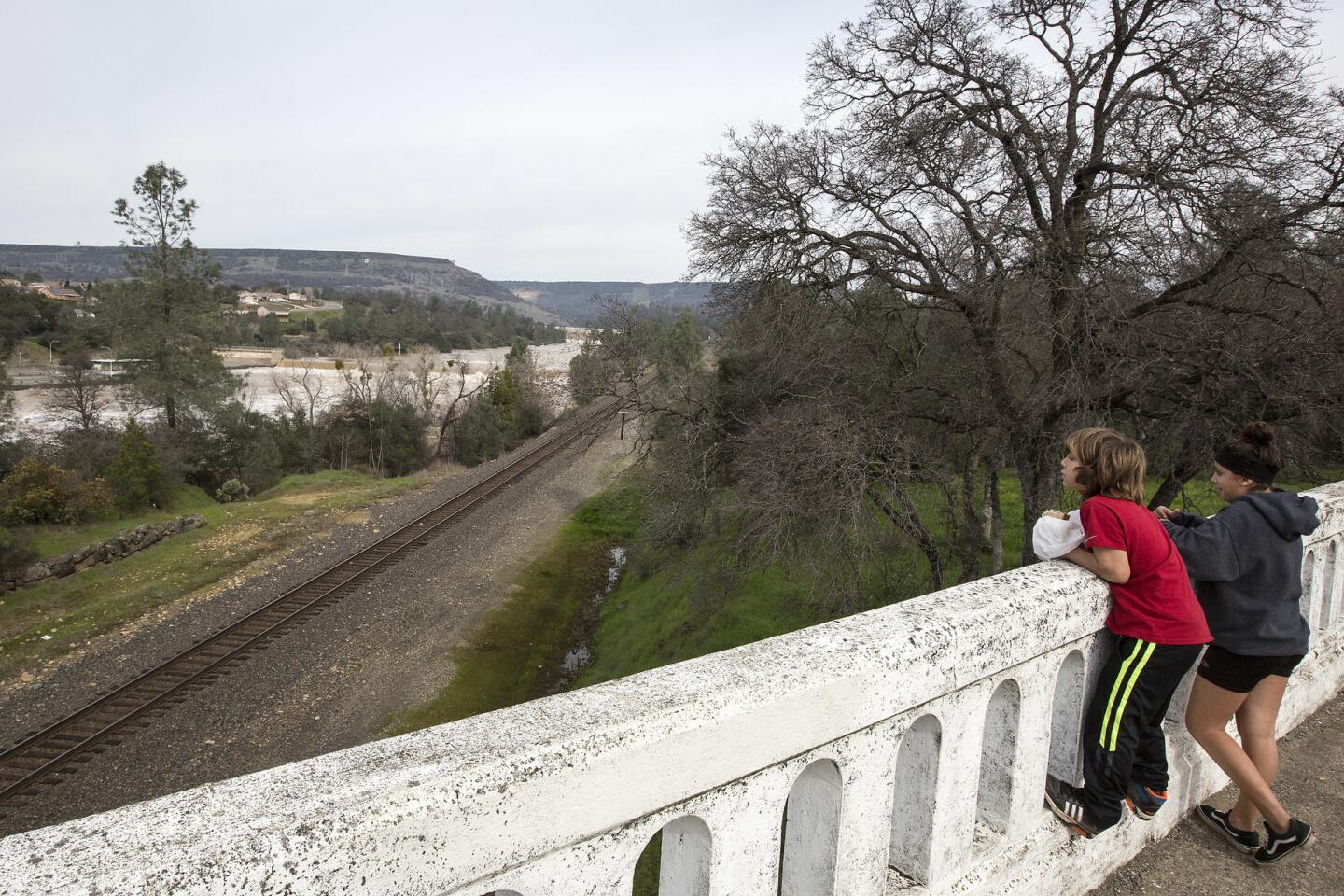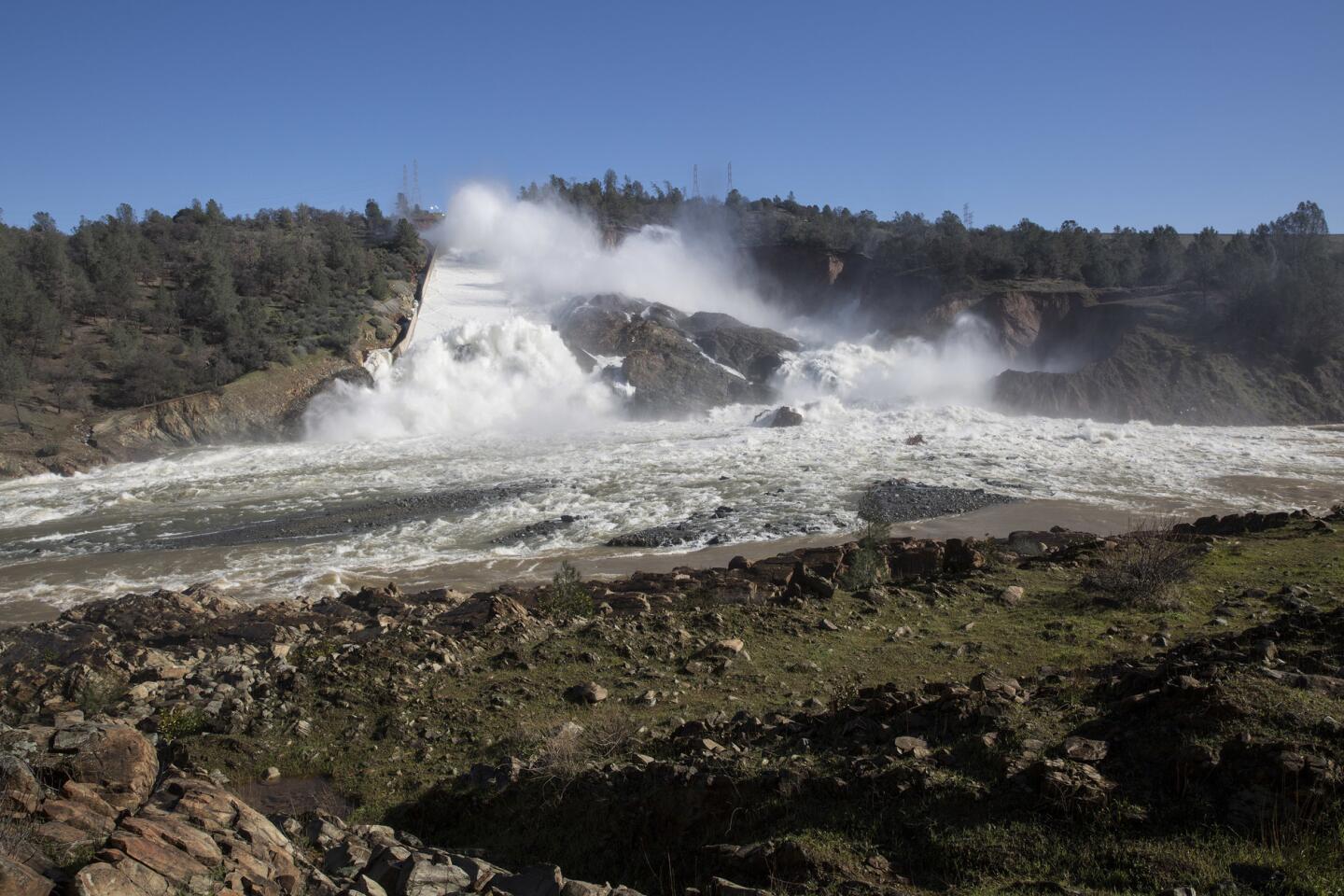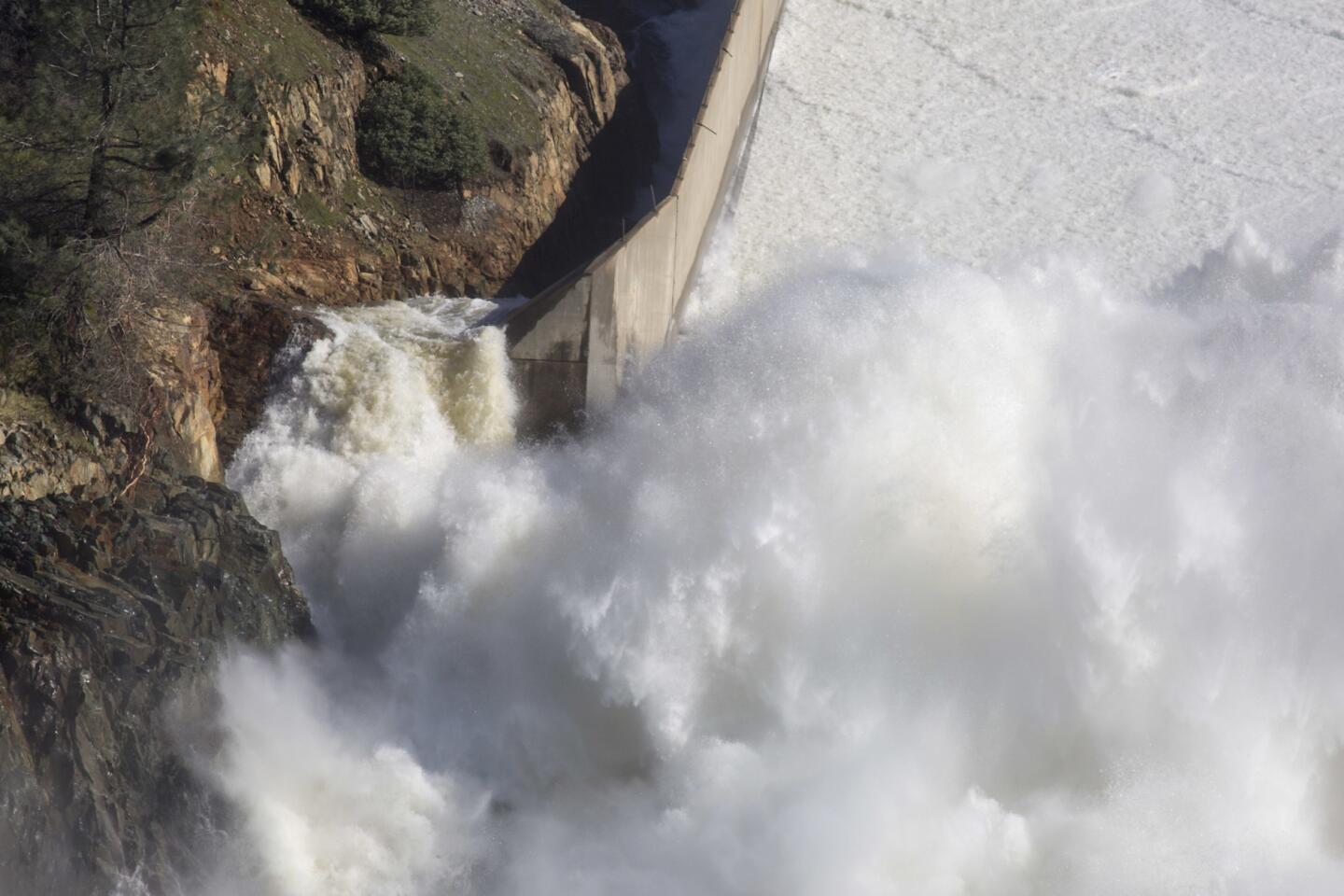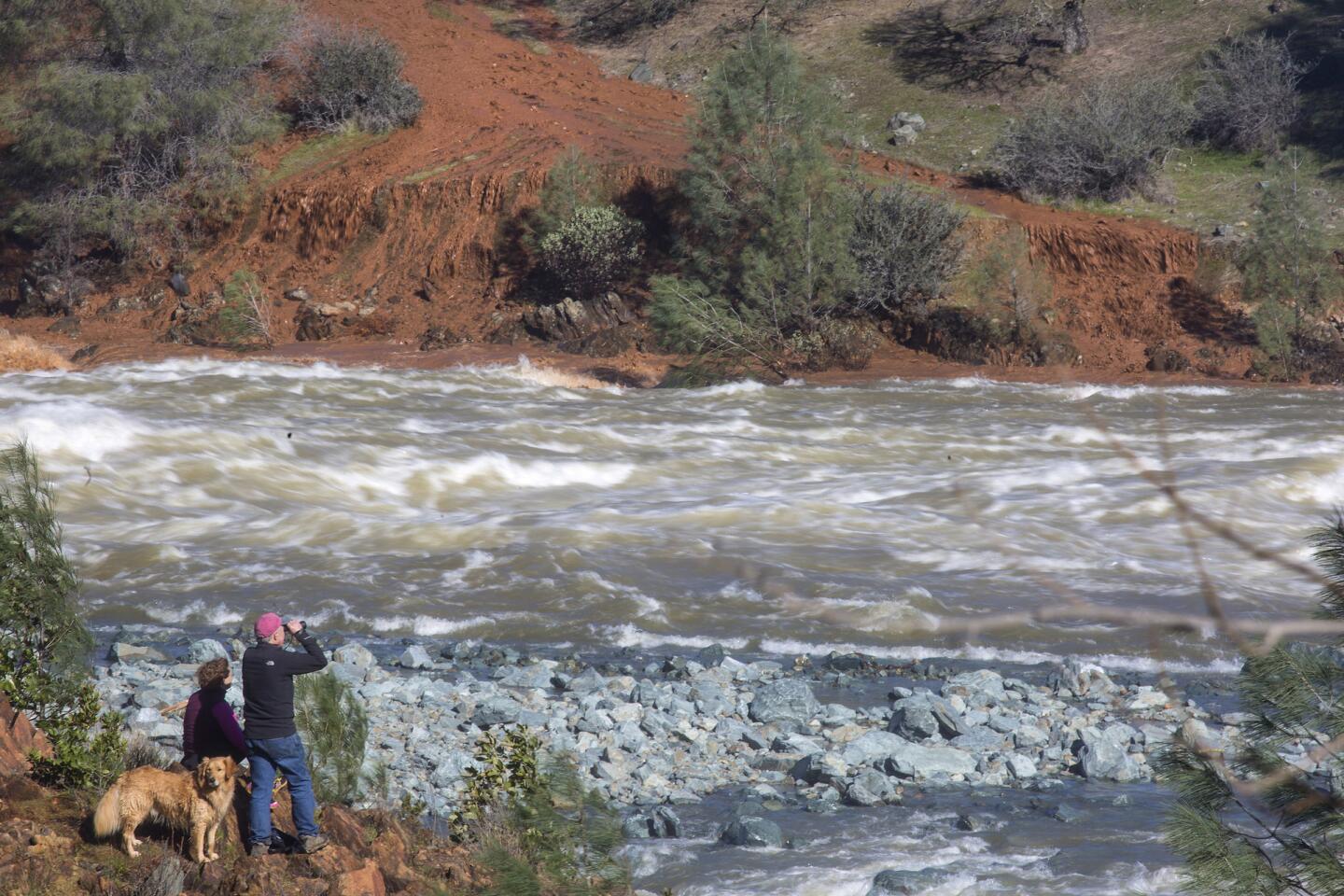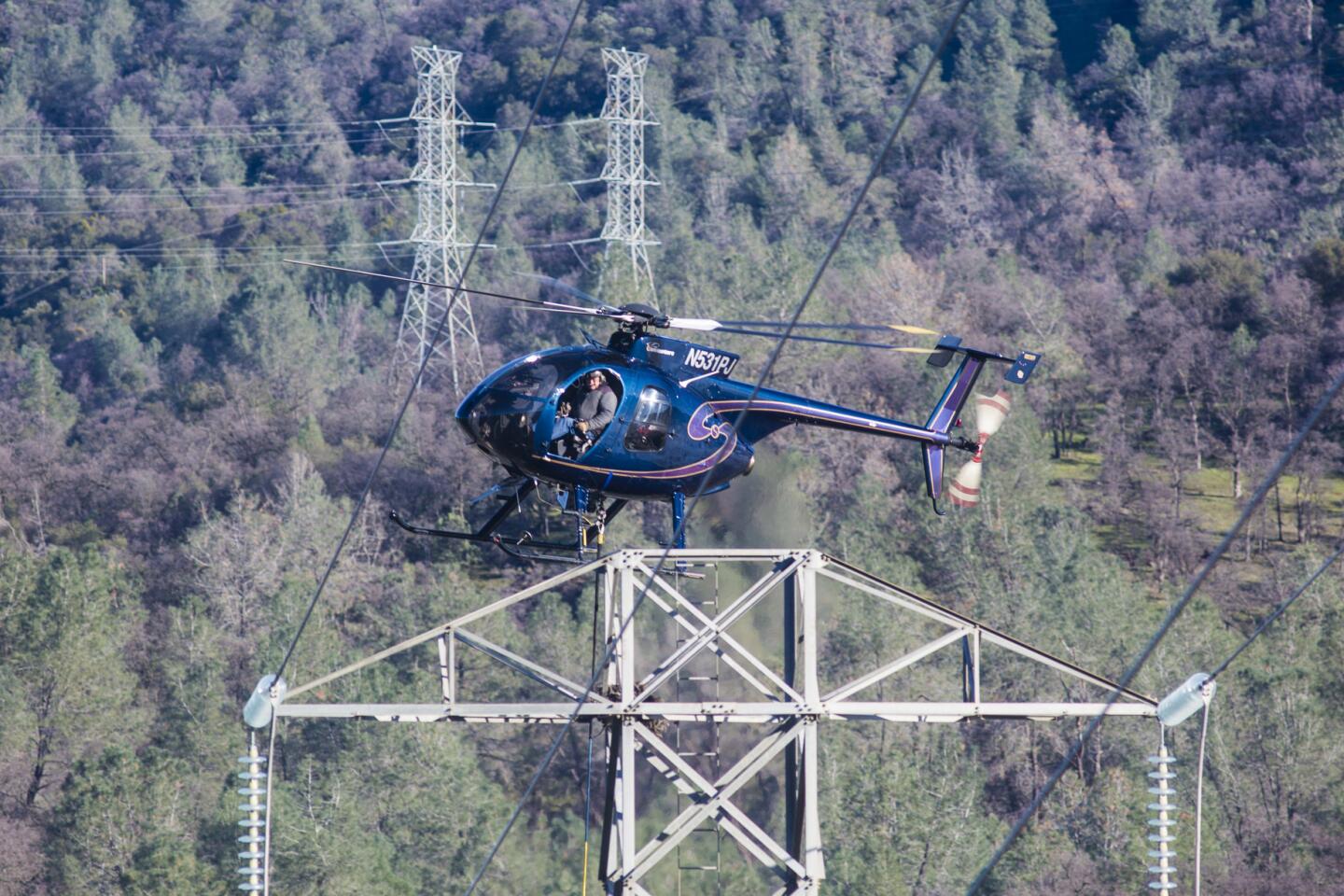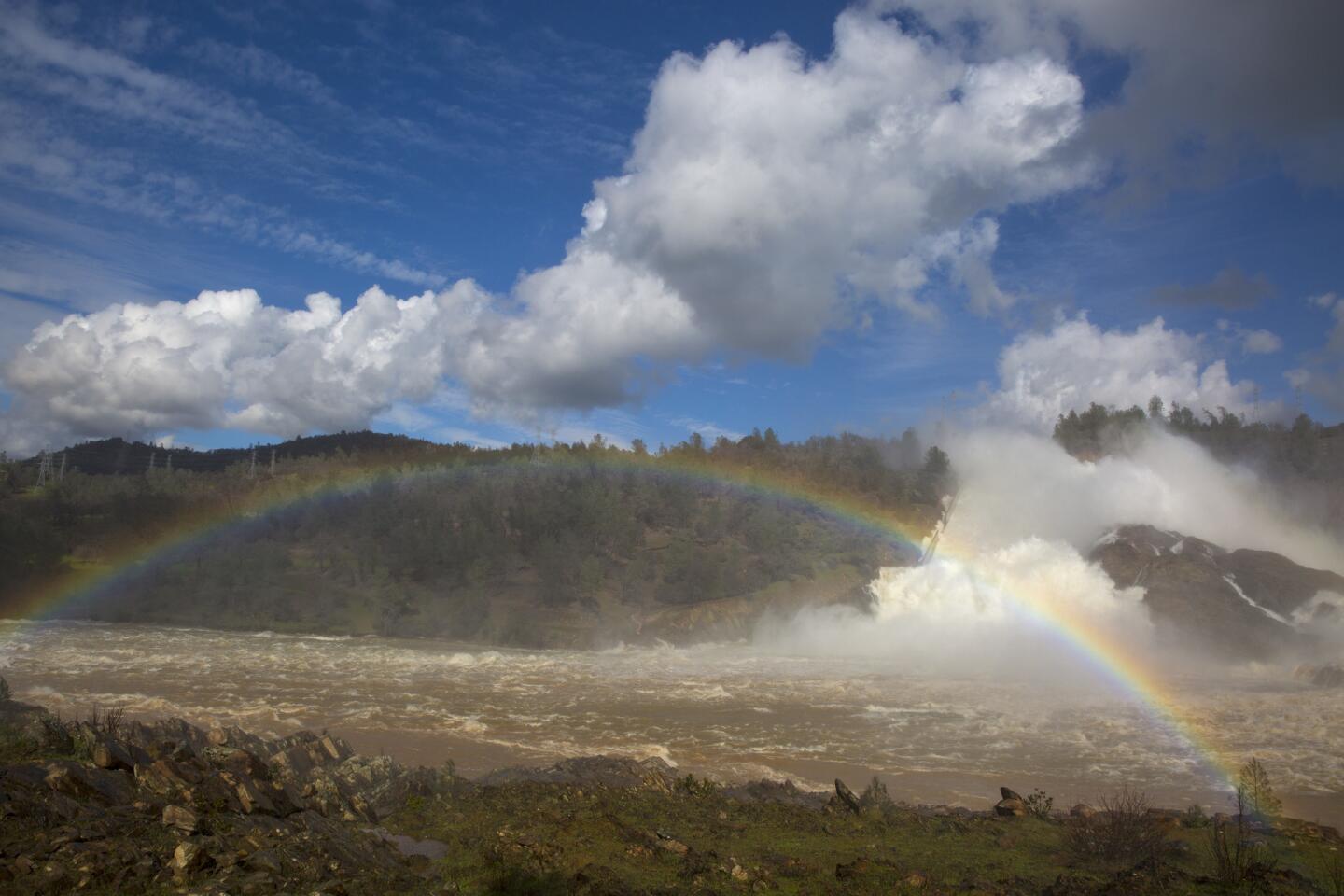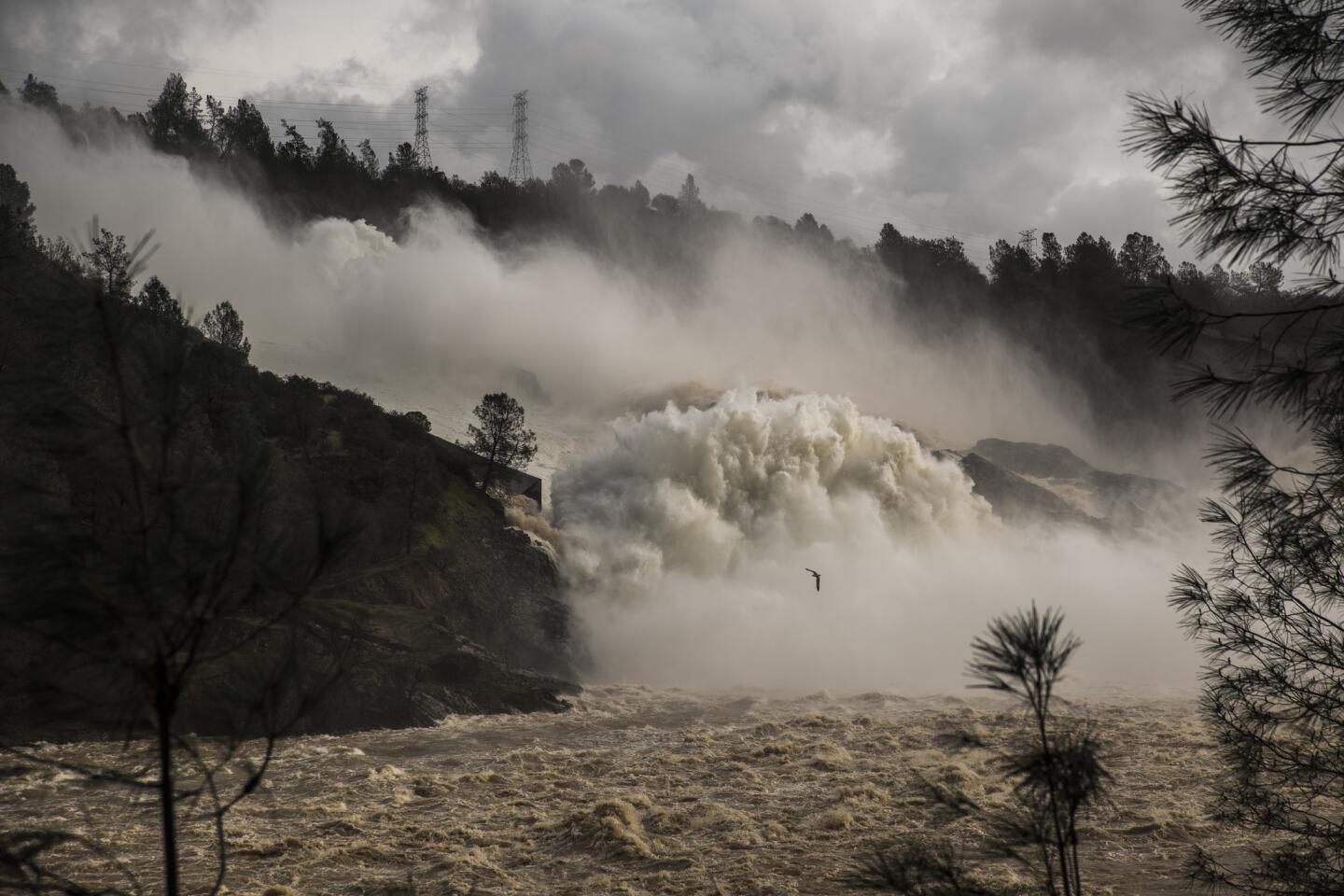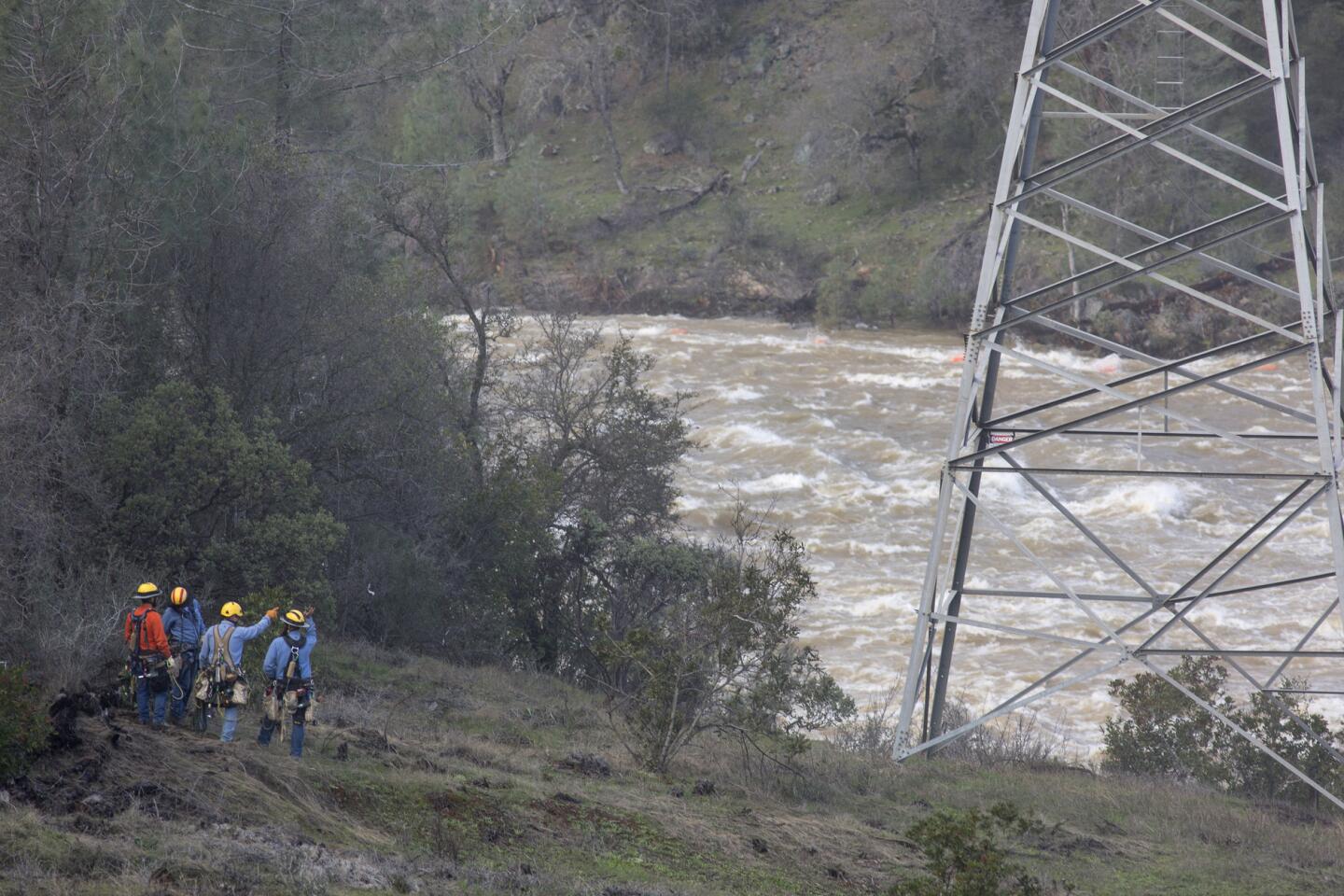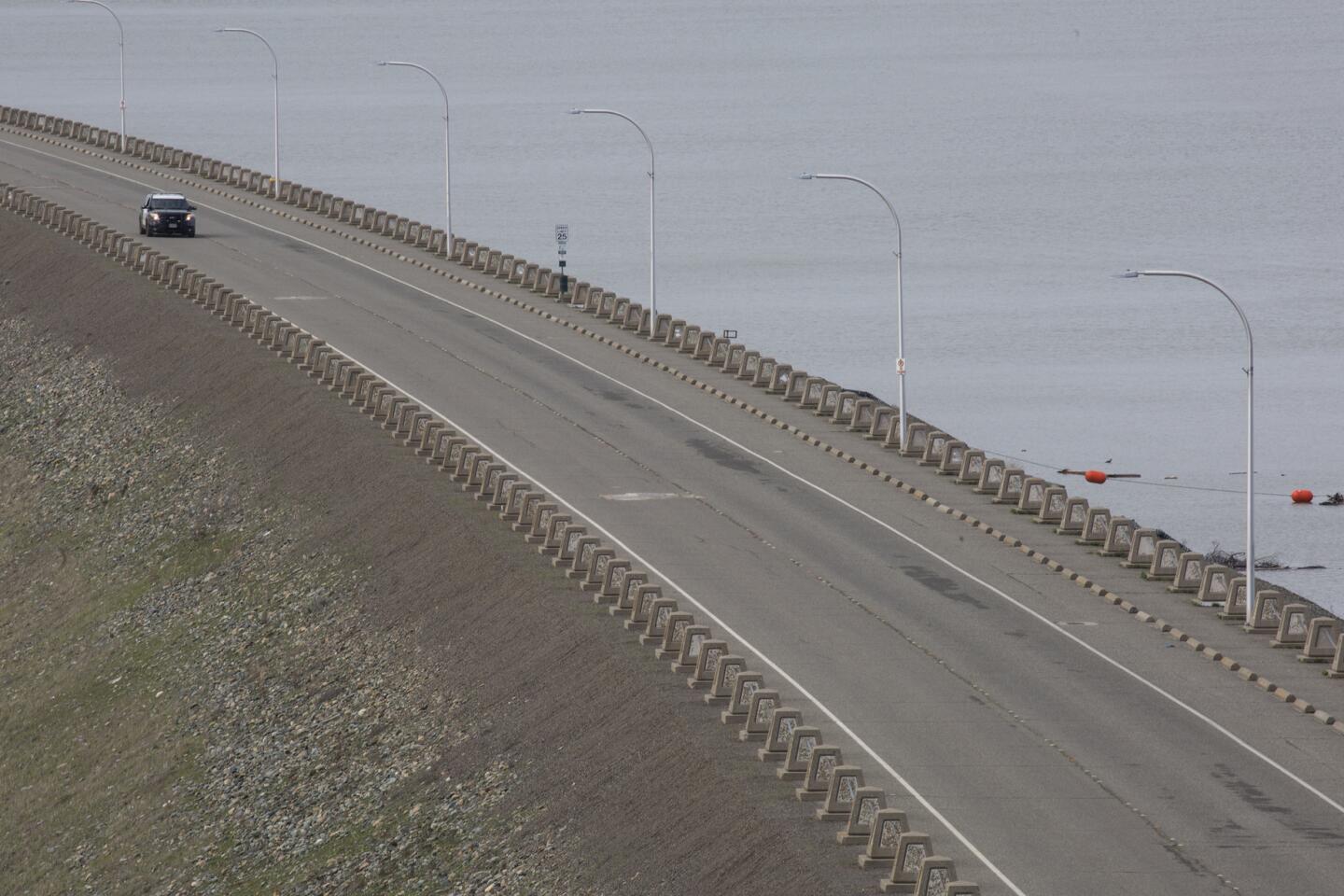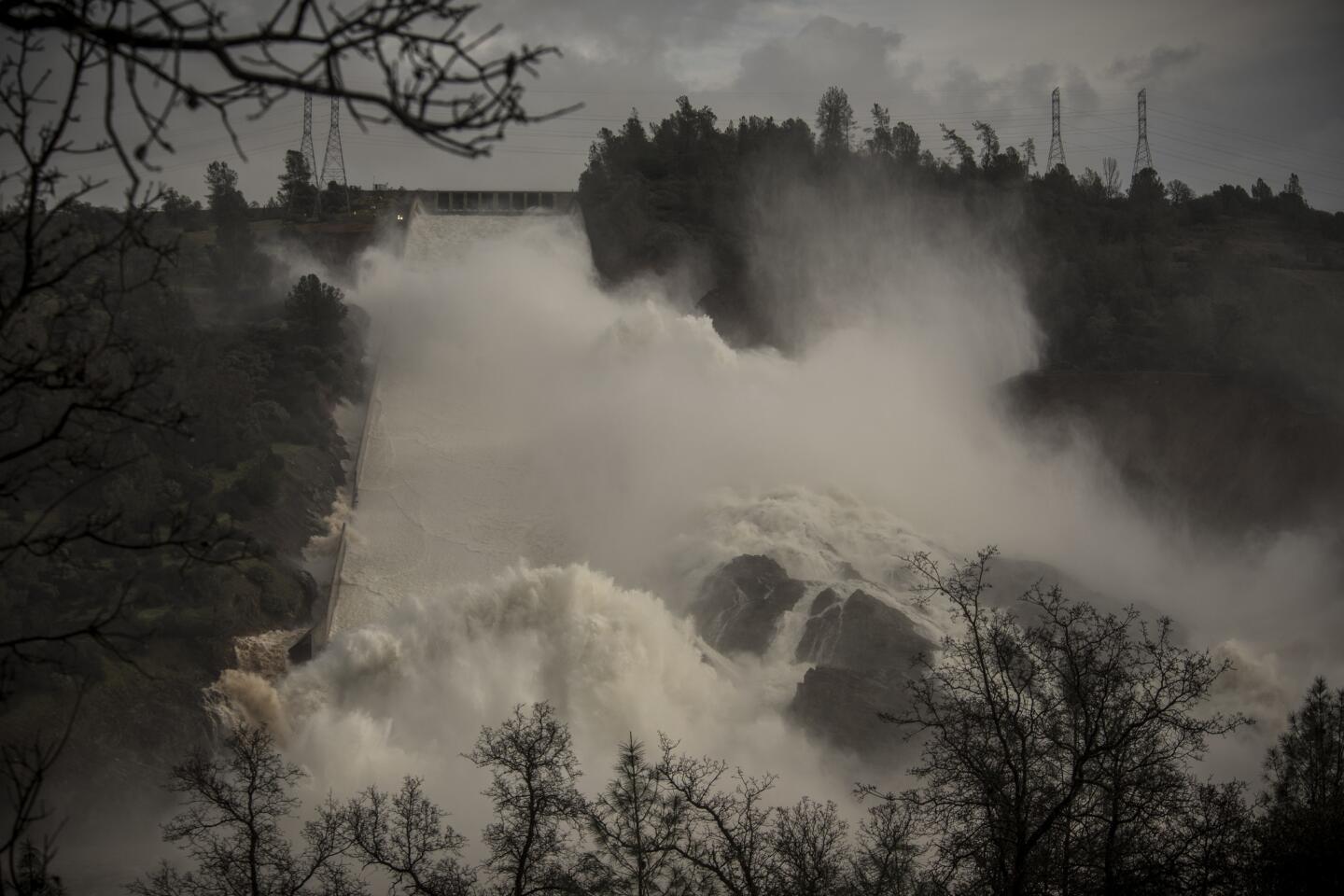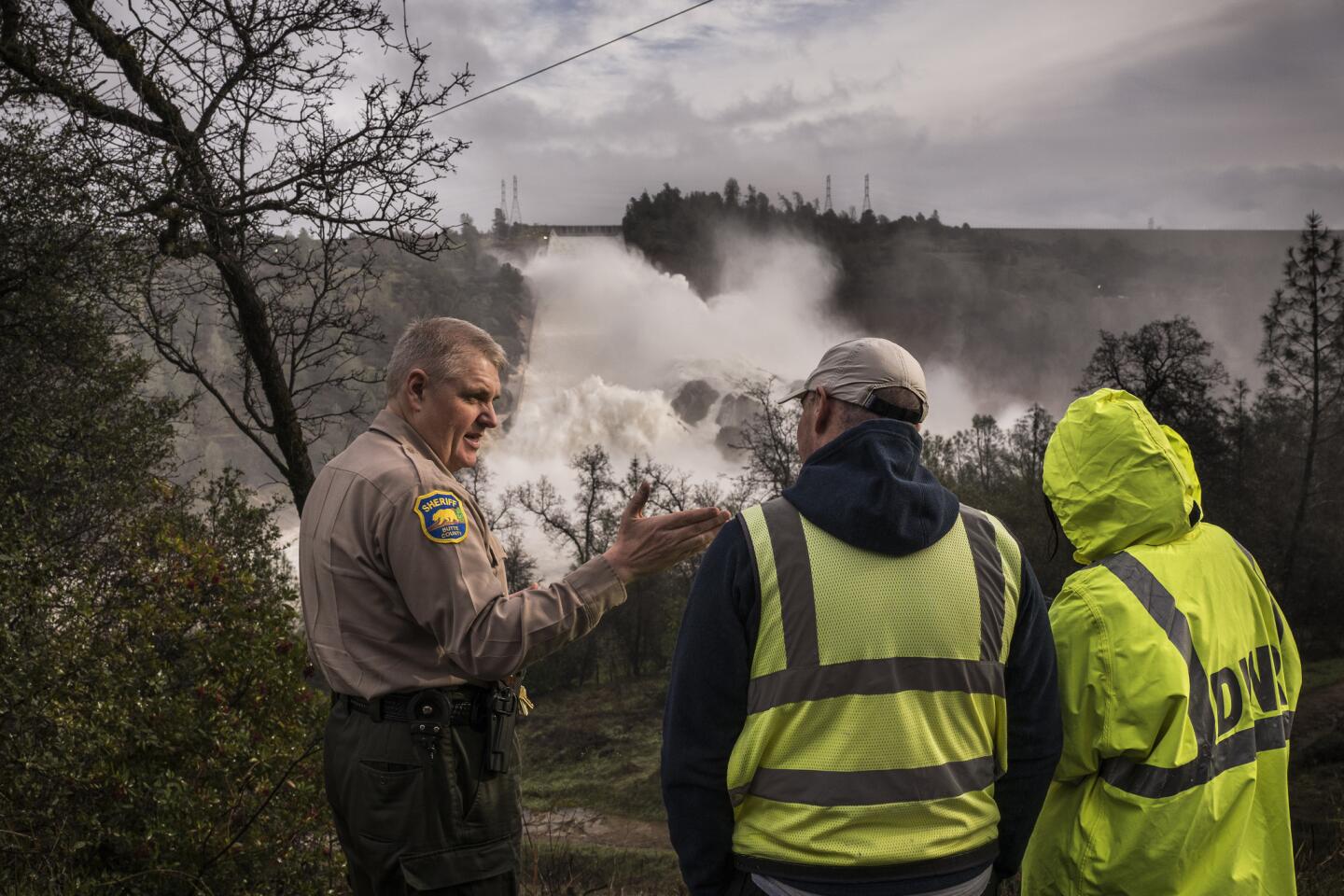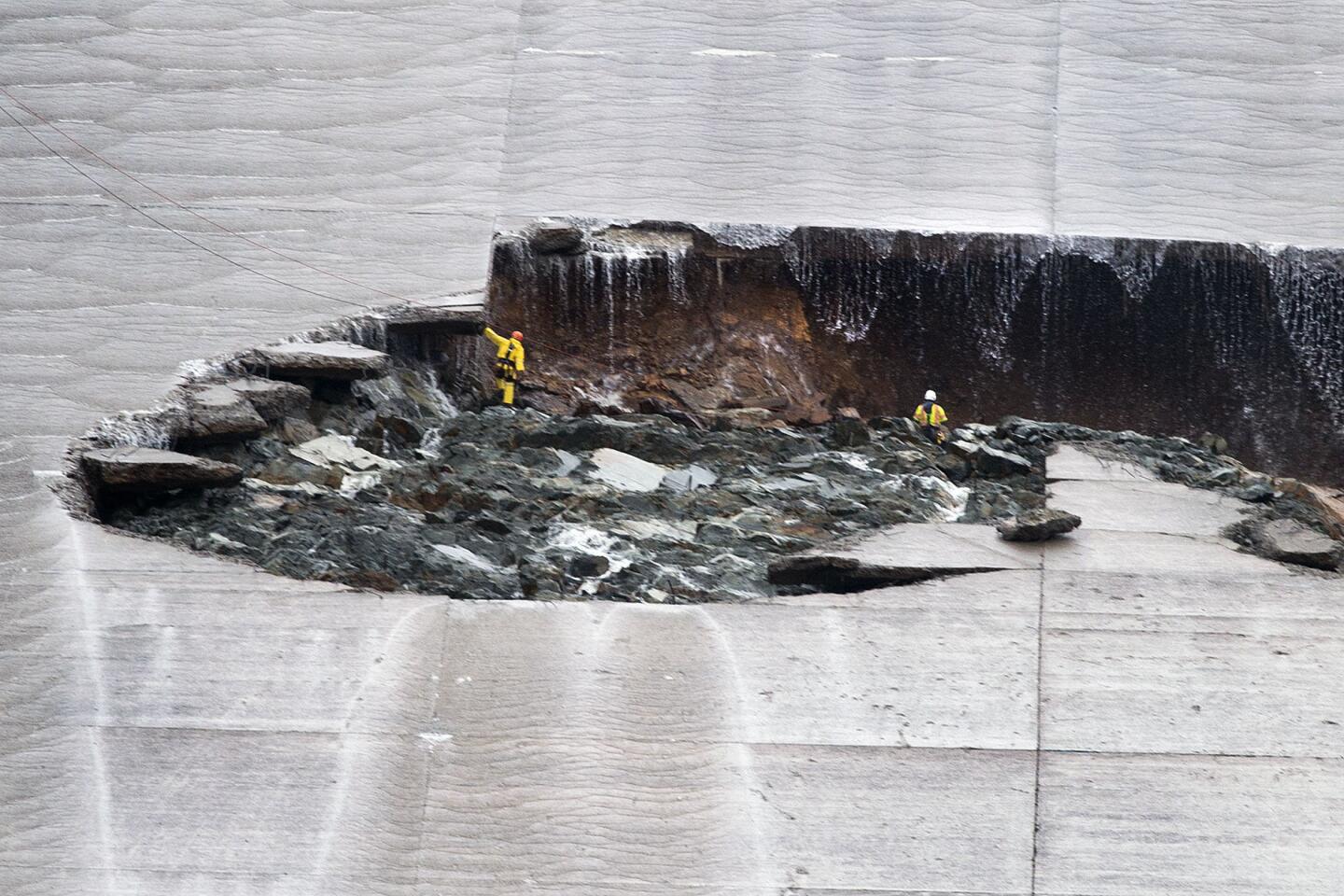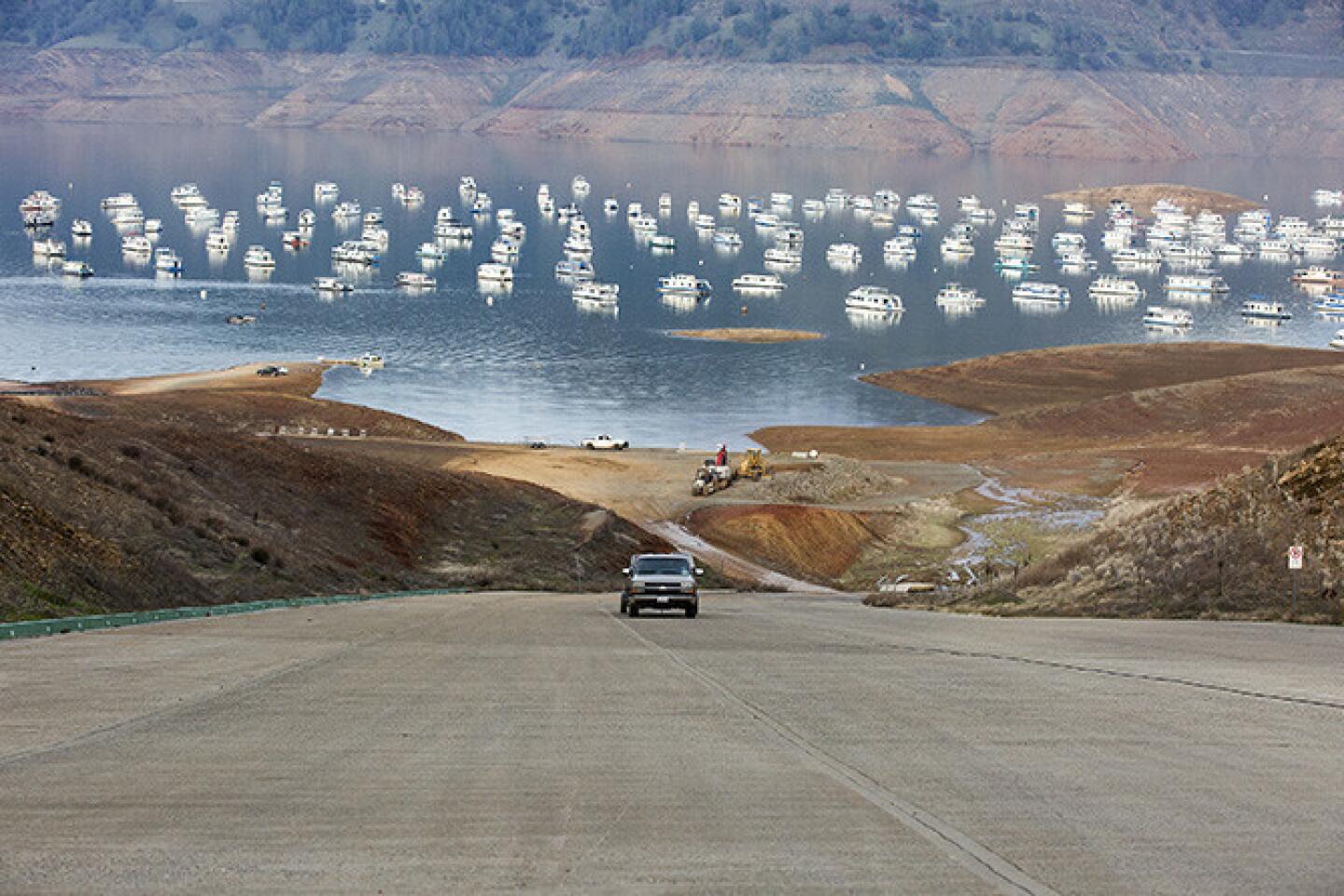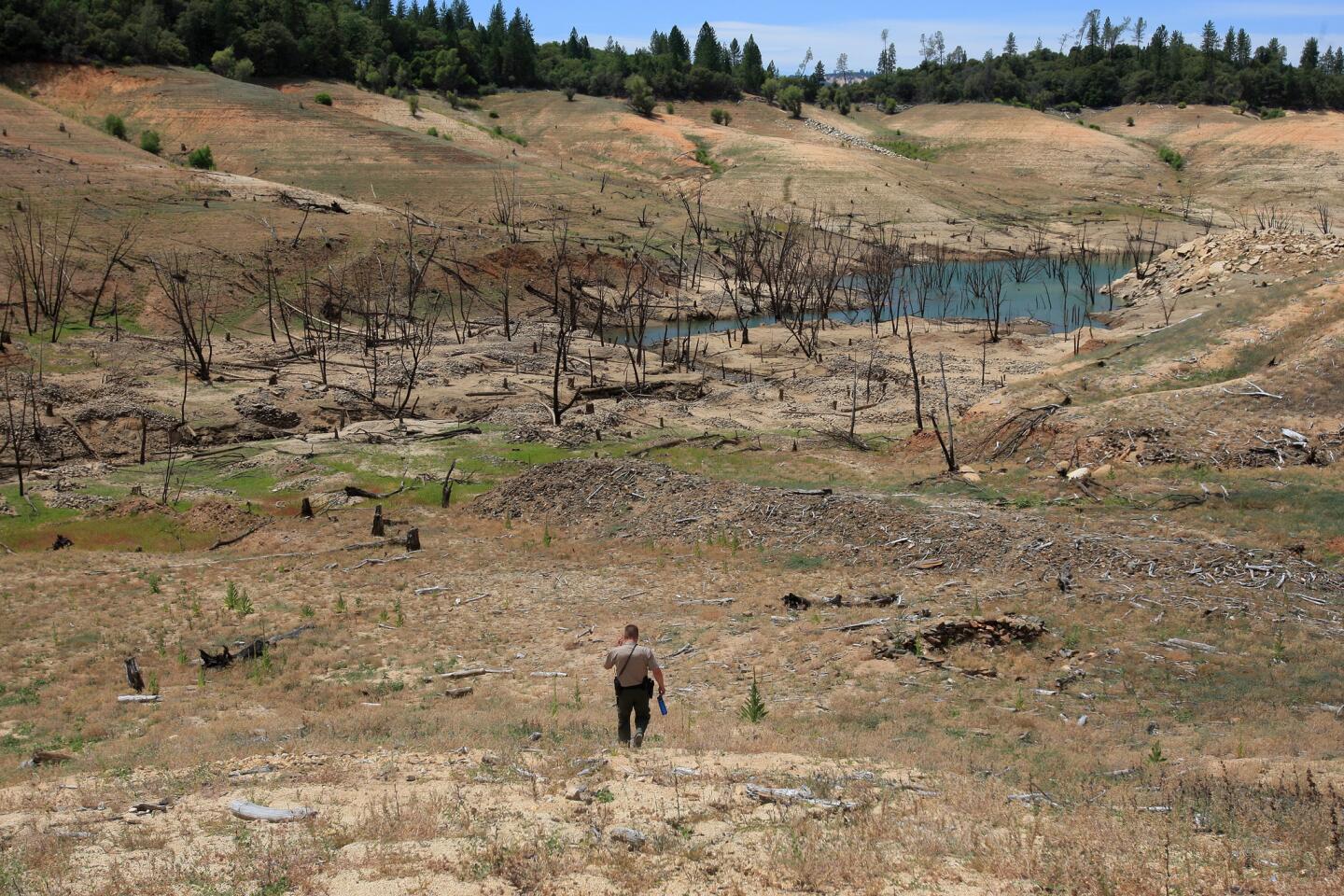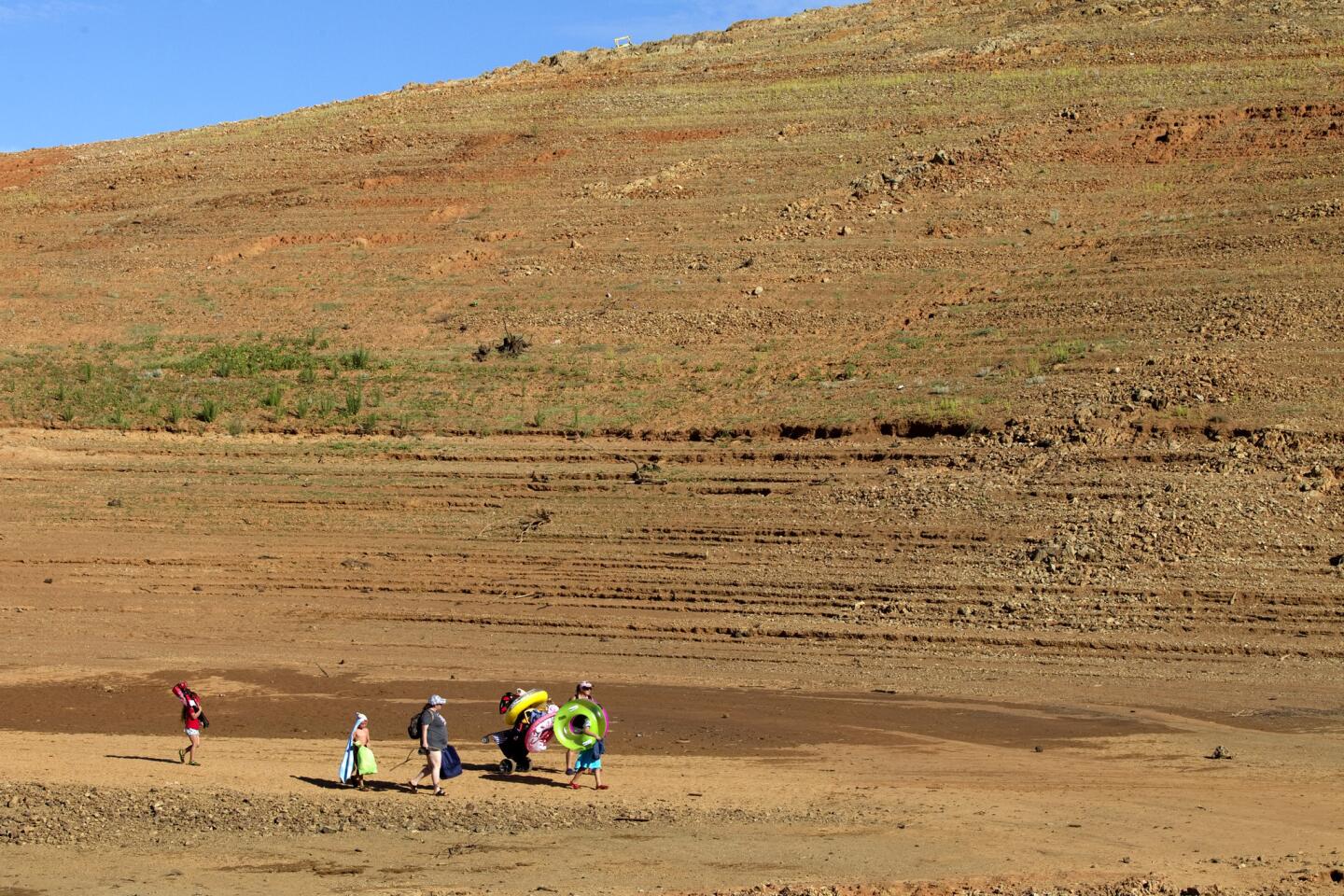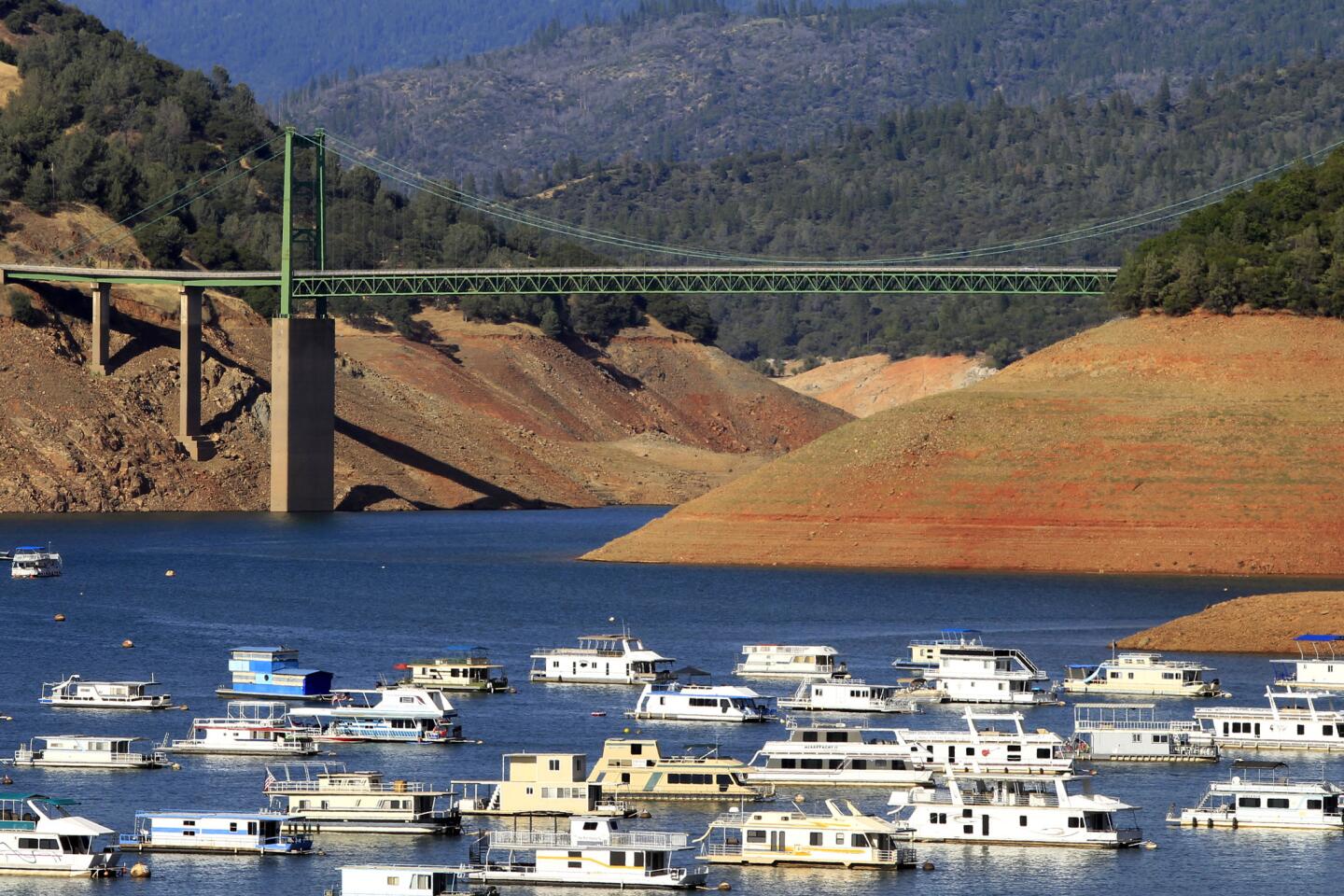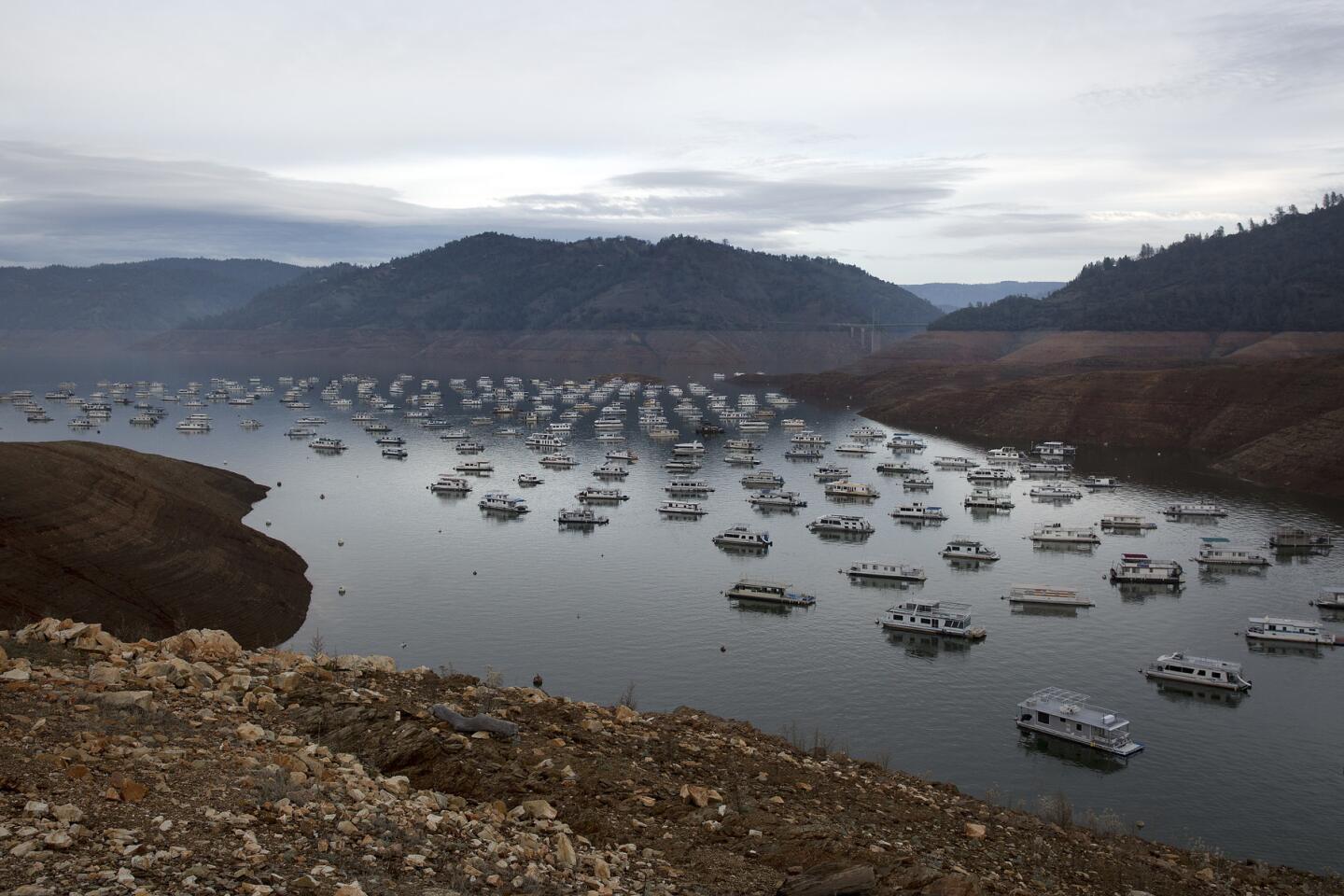Bill Croyle stood in front of an aerial photo of Lake Oroville and swept his hand across the top of the emergency spillway that was helping drain water out of the brimming reservoir.
âSolid rock. All this is rock,â Croyle, acting director of the Department of Water Resources, said with an air of confidence at the Feb. 11 briefing.
The flows over the concrete lip of the unpaved spillway were tiny compared with what it was designed to handle. Orovilleâs first-ever emergency spill was going smoothly.
Some 27 hours later, state officials told Butte County Sheriff Kory Honea that erosion was chewing away at the base of the spillwayâs concrete lip. It was on the verge of collapse, threatening to send a towering wall of flood water surging through downstream communities, endangering tens of thousands of people. Honea ordered a mass evacuation.
The erosion slowed and dam managers succeeded in getting enough water out of the reservoir to stop the emergency spill late Feb. 12. California narrowly averted what could have been one of the worst dam disasters in state history.
Interviews and records suggest that the near-catastrophe grew out of fundamental problems with the original design of the emergency spillway that were never corrected despite questions about its adequacy.
1/66
An aerial view of the water flowing out of the Oroville Dam main spillway, in Oroville, Calif., on Tuesday, February 21, 2017.
(Marcus Yam / Los Angeles Times) 2/66
An aerial view of the water flowing out of the Oroville Damâs main spillway on Feb. 21. (Marcus Yam / Los Angeles Times)
3/66
Reduced water releases at the Oroville Dam have made damage to its main spillway more visible. (Marcus Yam / Los Angeles Times)
4/66
With a reduced flow on Sunday, most of the water being released from the Oroville Dam is not going down the spillway; it has broken through and is flowing down the hillside. (Marcus Yam / Los Angeles Times)
5/66
With a reduced flow on Sunday, most of the water being released from the Oroville Dam is not going down the spillway, itâs broken through and is going down the hillside.
(Marcus Yam / Los Angeles Times) 6/66
With a reduced flow on Sunday, most of the water being released from the Oroville Dam is not going down the spillway, itâs broken through and is going down the hillside.
(Marcus Yam / Los Angeles Times) 7/66
Juan Alvarez reassures his girlfriend, Sarah Hendrix, after helping her move out of her home in rural Maxwell. Water was a foot high and crews had to evacuate 100 people because of flooding-- some by boat.
(Marcus Yam / Los Angeles Times) 8/66
Ron Chambers lets Duke out of his crate for the first time in hours since the flooding began n Maxwell, Calif. on Saturday.
(Marcus Yam / Los Angeles Times) 9/66
Kevin Anfinson and other volunteers help shovel the muddy sediment that has built up in the salmon raceway at the Feather River Fish Hatchery in Oroville, Calif. (Marcus Yam / Los Angeles Times)
10/66
Fernando Martinez and his mother, not pictured, wade through a road in Gridley, Calif., flooded by the Feather River as it continues to swell from the water being let out of Lake Oroville.
(Marcus Yam / Los Angeles Times) 11/66
A man in a 4x4 truck turns around on Gridley Road after having second thoughts about making it across the flooded road, which had been closed.
(Brian van der Brug / Los Angeles Times) 12/66
Randy Boheim packs up his tools and emergency supplies in anticipation of having to evacuate his whole family as floodwaters creep closer to his home in an Oroville, Calif., mobile home park. The nearby Feather River continued to swell from the water being let out of Lake Oroville ahead of this weekendâs storm.
(Marcus Yam / Los Angeles Times) 13/66
A plantation in Oroville, Calif., sits in floodwaters as the Feather River continues to swell from the water being let out of Lake Oroville ahead of this weekendâs storm.
(Marcus Yam / Los Angeles Times) 14/66
Helicopters ferry sand and rocks to the Oroville Damâs emergency spillway reconstruction project in Oroville, Calif., ahead of coming rains.
(Brian van der Brug / Los Angeles Times) 15/66
California Water Service district manager Toni Ruggle surveys the Feather River at Bedrock Park downstream from the Oroville Dam.
(Brian van der Brug / Los Angeles Times) 16/66
McKenna Harvey, 9, left, Kylie Atteberry, 11, and Brooklyn Atteberry, 7, hold signs thanking workers in the repair effort at the Oroville Dam.
(Brian van der Brug / Los Angeles Times) 17/66
A helicopter flies over as water flows from the main spillway at Lake Oroville. (Marcus Yam / Los Angeles Times)
18/66
Reconstruction continues in a race to shore up the emergency spillway at Oroville Dam. (Brian van der Brug / Los Angeles Times)
19/66
As rain clouds gather, friends from left, Johnny Eroh, Cody Balmer, Kristien Bravo and Jerel Bruhn hang out by the flooded Feather river in the Bedrock neighborhood of Oroville, Calif., last week. (Marcus Yam / Los Angeles Times)
20/66
Evacuees at the Bangor Community Hall in Bangor, Calif., listen to Butte County sheriffâs deputies in February as the mandatory evacuation order was lifted. An evacuation advisory was lifted Wednesday. (Brian van der Brug / Los Angeles Times)
21/66
Evacuees at the Bangor Community Hall get the news from Butte County sheriffâs Deputy Jeff Heath that the evacuation order has been lifted.
(Brian van der Brug / Los Angeles Times) 22/66
Evacuee Sharon Dalton, right, hugs Raiden Ellis, 10 months, and Chris Ellis as they say their goodbyes as she leaves the Bangor Community Hall in Bangor, Calif., on Tuesday.
(Brian van der Brug / Los Angeles Times) 23/66
David McGlamery returns to his Oroville home with his belongings after the evacuation order was lifted. The family had to retreat to Chico, where they initially stayed at a Walmart parking lot with other evacuees. (Marcus Yam / Los Angeles Times)
24/66
Bill Tirey helps family members move back into their home in the Bedrock neighborhood of Oroville near the Feather River after evacuation orders were lifted.
(Marcus Yam / Los Angeles Times) 25/66
Maria Alancar returns home to greets her pet pig Bacon, who was left behind when the family moved to higher ground in Honcut, Calif.
(Brian van der Brug / Los Angeles Times) 26/66
Sulet Lopez, 21, left, Melissa Mendoza, 3, and Yeanet Lopez, 18, pack up their car at the Bangor Community Hall in Bangor, Calif., to head home after the evacuation order was lifted.
(Brian van der Brug / Los Angeles Times) 27/66
Erica Stenholm, left, Ronnie Vaughan, and Brooklyn Jackson, 7, unpack their car upon returning home after the evacuation order had been lifted in Oroville.
(Marcus Yam / Los Angeles Times) 28/66
Jonah Avina, left, and his wife, Eileen, pray before lunch at the Maranatha Mennonite Fellowship in Bangor, Calif., on Tuesday. The Bangor-area Mennonites are hosting several immigrant families evacuated from the nearby town of Honcut.
(Brian van der Brug / Los Angeles Times) 29/66
Evacuee Estafani Reynoso, left, colors with Mennonite children at the Maranatha Mennonite Fellowship in Bangor, Calif.
(Brian van der Brug / Los Angeles Times) 30/66
Crews work on a damaged section of the emergency spillway at Lake Oroville on Monday. (Josh Edelson / AFP/ Getty Images)
31/66
An Oroville property is flooded on Monday as thousands were under evactuation orders.
(Josh Edelson / AFP/Getty Images) 32/66
The Marysville cemetery underwater along the Feather River.
(Marcus Yam / Los Angeles Times) 33/66
Nirmal Singh, a Sikh priest, conducts a morning prayer ritual as evacuees sleep in the background at the Shri Guru Ravidass, a Sikh temple that has opened its doors for evacuees of the Oroville Dam crisis in Rio Linda, Calif.
(Marcus Yam / Los Angeles Times) 34/66
Kamlesh Nahar, far left, talks to fellow evacuees at the Shri Guru Ravidass Temple.
(Marcus Yam / Los Angeles Times) 35/66
Maria Lopez reads on her smartphone as she spends a second night in her fatherâs car in the parking lot of the Bangor Community Hall.
(Brian van der Brug / Los Angeles Times) 36/66
Sharon Dalton finds a quiet spot under a table as she spends a second night with her dog Cruiser inside the Bangor Community Hall.
(Brian van der Brug / Los Angeles Times) 37/66
Verna Chadwick and 10-month-old son Raiden Ellis during a second night in the Bangor Community Hall.
(Brian van der Brug / Los Angeles Times) 38/66
The emergency spillway, left, and the damaged main spillway at Lake Oroville are seen in an aerial photo Monday.
(Elijah Nouvelage / Getty Images) 39/66
A dump truck crosses the primary spillway to deliver boulders to the damaged emergency spillway at Lake Oroville on Monday evening.
(Brian van der Brug / Los Angeles Times) 40/66
Helicopters place large rocks on the damaged emergency spillway at Lake Oroville on Monday evening.
(Brian van der Brug / Los Angeles Times) 41/66
Around-the-clock monitoring continues on the damaged primary spillway at Lake Oroville on Monday evening.
(Brian van der Brug / Los Angeles Times) 42/66
Water rushes down a spillway at the Oroville Dam. (Brian van der Brug / Los Angeles Times)
43/66
California Department of Fish and Game wardens view the damaged spillway on Monday. (Brian van der Brug / Los Angeles Times)
44/66
Bill OâKelley, 86, and wife Doris OâKelley, 84, of Oroville sit near a flagpole Monday at the Silver Dollar Fairgrounds evacuation center in Chico, Calif.
(Brian van der Brug / Los Angeles Times) 45/66
Coua Tha, of Oroville prepares a meal for her family in the parking lot at the Silver Dollar Fairgrounds evacuation center in Chico, Calif.
(Brian van der Brug / Los Angeles Times) 46/66
Desiree Garcia and daughter Kayâlee Pearl Garcia, 3, of Oroville look over donated clothing Monday at the Silver Dollar Fairgrounds evacuation center in Chico, Calif.
(Brian van der Brug / Los Angeles Times) 47/66
Members of Orovilleâs Jordan Crossing Mission pray with a volunteer service member Monday at the Silver Dollar Fairgrounds evacuation shelter in Chico, Calif.
(Brian van der Brug / Los Angeles Times) 48/66
The swollen Feather River flows through Oroville, Calif., on Monday.
(Rich Pedroncelli / Associated Press) 49/66
A building is submerged in Riverbend Park as more water is released from Lake Oroville.
(JOSH EDELSON / AFP) 50/66
Siblings Zach Soto, 11, left, and Gabby Soto, 13, keep an eye on the Feather River along a railroad bridge in Oroville, Calif., on Monday. The family decided to stay in Oroville as they live on high ground near downtown.
(Brian van der Brug / Los Angeles Times) 51/66
Water flows down the damaged main spillway of the Oroville Dam at 55,000 cubic feet per second into the Feather River. (Brian van der Brug / Los Angeles Times)
52/66
Water from Lake Oroville flows down the damaged main spillway.
(Brian van der Brug / Los Angeles Times) 53/66
Water from Lake Oroville flows down the emergency spillway of the Oroville Dam toward the Feather River.
(Brian van der Brug / Los Angeles Times) 54/66
Pacific Gas & Electric crews aided by a helicopter removed transmission lines and insulators from towers standing in the bed of the emergency spillway of Lake Oroville.
(Brian van der Brug / Los Angeles Times) 55/66
A rainbow appears over Feather River as water cascades down the damaged spillway at Lake Oroville Dam.
(Brian van der Brug / Los Angeles Times) 56/66
Water cascades down the spillway below Oroville Dam. The water is being released by authorities to avoid flooding at Lake Oroville because of recent heavy rain. (David Butow / For The Times)
57/66
Pacific Gas and Electric Co. crews move two electric transmission line towers on the bank of Feather River as a precaution if the Lake Oroville Dam emergency spillway needs to be used.
(Brian van der Brug / Los Angeles Times) 58/66
A California Highway Patrol cruiser patrols Lake Oroville Dam, which is closed to the public due to the damaged spillway.
(Brian van der Brug / Los Angeles Times) 59/66
Water cascades down the spillway below the Oroville dam. The water is being released by authorities to ease flooding in Lake Oroville because of recent heavy rain.
(David Butow / For the Times) 60/66
Butte Country Sheriff Kory L. Honea speaks with department of water and power workers at an overlook as the observe runoff from the Oroville Dam.
(David Butow / For the Times) 61/66
Water trickles down as workers inspect part of the Lake Oroville spillway failure in Oroville, Calif.
(Randy Pench / Associated Press) 62/66
A boat launch at Bidwell Canyon is still hundreds of yards above the current lake level on Jan. 21, 2016.
(Brian van der Brug / Los Angeles Times) 63/66
California State Park Ranger Bryan Taylor searches for signs of disturbance or theft as Californiaâs severe drought conditions are revealing historic artifacts at Lake Oroville, June 21, 2014.
(Allen J. Schaben / Los Angeles Times) 64/66
Severe drought conditions are evident as a family treks across a long path back to their car at Lake Oroville, June 21, 2014.
(Allen J. Schaben / Los Angeles Times) 65/66
Houseboats are dwarfed by steep banks that show the water level down 160 feet from the high water mark at the Bidwell Bar Suspension Bridge over Lake Oroville on June 21, 2014.
(Allen J. Schaben / Los Angeles Times) 66/66
Houseboats at Bidwell Canyon Marina at Lake Oroville, January 21, 2016.
(Brian van der Brug / Los Angeles Times) The âsolidâ bedrock that Croyle thought would stand up to the force of the spill was soft and easily eroded. The long concrete lip of the spillway was not anchored into the rock. Critical power lines were strung across the spillway, which consists of nothing more than an earthen hillside covered with trees and brush.
âThere is no way to rationalize running water down a hillslope with deep soils and a forest on it and weak bedrock,â said Jeffrey Mount, a UC Davis emeritus professor of geology and expert on California water.
Federal and state officials said the cause of the spillwayâs near-failure was under investigation.
The key reservoir in the State Water Project that typically provides Southern California with roughly a third of its supplies, Oroville started operation in 1968. Routine water releases are made through the powerhouse at the base of the dam, which is the nationâs tallest.
Higher releases go down the main spillway, a long, gated concrete chute off to the side of the dam. The emergency spillway â which until Feb. 11 had never been used â is to the side of the main spillway.
After a hole big enough to swallow a small house appeared in the main spillway, chunks of concrete and dirt tumbled into the channel at the base of the dam, raising water levels and forcing managers to stop the powerhouse discharges.
Operators reduced flows down the main spillway to avoid further damage, leaving them with limited discharge abilities just as storm runoff was pouring into the lake. Oroville â which at the same date a few years ago was less than 40% full â was suddenly full to the brim.
The morning of Feb. 11, what Croyle called âa little waterâ started spilling over the concrete lip like an overflowing bathtub. At the peak of the spill, roughly 1 ½ feet of water was sheeting out of the reservoir, spreading over the top of the hill and forming a stream as it followed a ravine down to the Feather River.
The 1,700-foot long lip, known as a weir, was supposed to handle up to a 16-foot flow over its top.
Beneath it was mostly schist, metamorphic rock that Mount described as weathered and fractured. It started to erode under the force of the spill.
âThere are unlined spillways elsewhere that perform well,â Mount said. âBut they tend to be in resistant rock, and this rock is not very resistant. That is one of the design errors, not fully considering how soft and erodible that bedrock is. This stuff is all busted.â
More than a decade ago, several environmental groups asked federal regulators to require the state to armor the hillside that forms the emergency spillway. The damâs operating rules called for use of the spillway as part of flood-control operations, they argued, so the slope needed to be armored to prevent damaging â and potentially dangerous â erosion.
In filings with the agency that oversees the dam â the Federal Energy Regulatory Commission â the groups cited a 2002 technical memo prepared for the Yuba County Water Agency that concluded emergency spills would cause extensive erosion on the hillside, potentially destroying high-voltage transmission towers and a road. Soil, rocks and debris would clog the Feather River.
Life below Oroville Dam: Stoicism, faith ... and cars poised for a fast getaway Âť
âWe had real concerns that even if the spillway itself didnât fail, moving all that erosion of topsoil down the river would cause major damage to a very important fishery,â said Allan Eberhart of the Sierra Club.
The 2005 filing by Friends of the River, the Sierra Club and the South Yuba River Citizens League also warned of âa loss of crest controlâ â which would have happened if the top of the spillway had collapsed, as it almost did Feb. 12.
A crumbling weir would have taken a dangerous bite out of the side of the reservoir, unleashing catastrophic torrents that Robert Bea, a UC Berkeley professor emeritus of engineering, said could have rushed more than 100 miles down the Feather and Sacramento rivers, breaching levees all the way to the Sacramento-San Joaquin River Delta.
In a May 2006 filing with FERC, the Department of Water Resources insisted that the emergency spillway was sound.
âDWR recently reviewed the geologic conditions at the emergency spillway and concluded that the spillway is a safe and stable structure founded on solid bedrock that will not erode,â the department stated. âThe Project Geology Section determined that there are only one to four feet of erodible top soil in the downstream area and that erosion would not compromise the stability of the emergency spillway.â
A few months later, an internal FERC memo echoed Water Resources, saying the spillway had been reviewed as part of a 2004 safety analysis: âIt is important to emphasize that during a rare event with the emergency spillway flowing at its design capacity, spillway operations would not affect reservoir control or endanger the dam,â states the memo by a FERC senior civil engineer.
âFERC patted us on the head and said itâs all good, donât worry about it,â said Ron Stork, a senior staffer at Friends of the River.
Stork is not an engineer, but his decades of river work have made him a dam geek. âI tried and failedâ to get the state to upgrade the spillway, he said. âMaybe nature gave us a wake-up call that what I suggested is needed.â
FERC spokeswoman Celeste Miller said the agency could not comment on the 2006 memo or the basis of it because the Oroville events were under review. The memo was written during a periodic review of the damâs operating license.
DWR spokeswoman Nancy Vogel said, âWe donât know the cause of the spillway erosion and we wonât know the cause until we get experts in there to do a full investigation and analysis.â
John France, a veteran dam safety consultant with Aecom, noted, âIn 1968, quite frankly, there werenât probably a lot of methodologies available to evaluate how rock erodes if you had flowing water on it.â
âCertainly we have to acknowledge that the performance we saw on that spillway was not consistent with [the DWR] conclusion,â he added. âWe saw a significant erosion occur in that formation with far less than the design amount of water that would go over that structure.â
When the spillway issue came up during relicensing, Mount said, the state could have dug test pits and conducted lab analysis of rock corings to determine if the bedrock was as strong as they thought it was.
âThey operated with an assumption that turned out to be incorrect,â he said.
Soft bedrock is not the only problem, he added. The concrete weir at the top of the emergency spillway was âjust plopped on top of that ridge. Itâs a design area that will probably get a lot of scrutiny and had to be a major concern as [the spillway] was eroding up the hill.â
Vogel confirmed that the weir, which she said ranges in height from 25 feet to 45 feet, was not anchored.
As to why the state never moved transmission lines that cross both spillways and connect the dam powerhouse to the electrical grid, Vogel said, âThe main spillway performed well for the past 50 years, so there was no perceived need to relocate.â
State contractors worked around the clock last week to strengthen the top of the emergency spillway with thousands of tons of rock sealed in place with concrete slurry as dam operators shoved as much water down the broken main spillway as they safely could.
By late Friday afternoon, reservoir levels had fallen more than 40 feet below the trigger point for emergency spills.
[email protected]
Twitter: @boxall
Staff writers Adam Elmahrek and Ralph Vartabedian contributed to this report.
ALSO
Oroville Dam is just part of Californiaâs crumbling infrastructure
Suspects identified in Oroville evacuation looting and robberies
Downstream from the stricken Oroville Dam, the Feather River Fish Hatchery manages to save millions of fish
Sikhs opened their temple doors to Oroville Dam evacuees â and strangers came pouring in
